Our Favorite Jewish Recipes Fit for a Thanksgiving Feast
21 Recipes
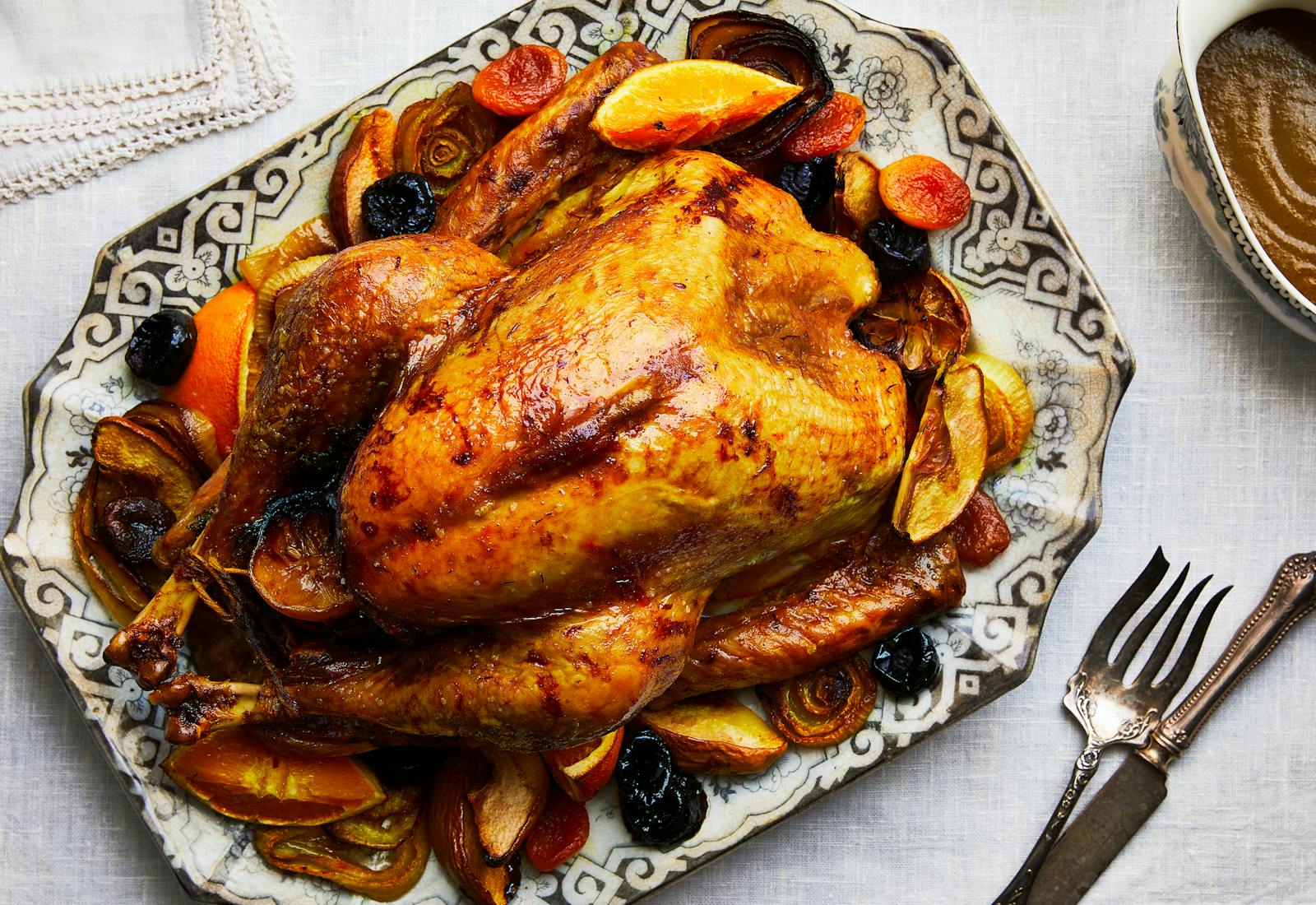
Our Favorite Jewish Recipes Fit for a Thanksgiving Feast
21 Recipes
While it’s not a Jewish holiday, Thanksgiving is a favorite amongst our team. For many American Jewish cooks, Thanksgiving recipes and traditions are an integral part of their family’s culinary canon. For our program director Amanda Dell, there’s no Thanksgiving dinner without her grandmother’s recipe for a whole turkey roasted in a brown paper bag (it comes out wonderfully moist with a crispy skin). There was even a year when her parents pushed their roasted turkey down the streets of New York City in a shopping cart so they could have it at a relative’s home.
As writer Tannaz Sassooni's Iranian family settled into life in Los Angeles, their Thanksgiving menu became a blend of Persian flavors and American traditions with dishes like turkey roasted with saffron and quince, and a rice dish called tahchin studded with dried cranberries and slivered almonds.
In some families, Jewish recipes are always part of the celebration. Becca Gallick-Mitchell explains that every year, she’s tempted to carve the Thanksgiving turkey poorly, leaving more meat on the bones. She uses what’s leftover to continue a kreplach tradition that’s five generations strong. And David Glick’s grandmother would serve yapsuk — a potato kugel on steroids, as he says — with gravy at Thanksgiving dinner.
In this collection, you will also find recipes for spinach and challah stuffing, sweet potatoes with sage, a deep dish apple strudel, and many others are welcome additions to the Thanksgiving table.
Looking for more Jewish recipes? Check out our archive and "The Jewish Holiday Table: A World of Recipes, Traditions & Stories to Celebrate All Year Long."
Recipes in This Collection
1. Roast Turkey with Saffron and Quince
2. Brown Paper Bag Turkey
Cooking Projects
3. Pomegranate Chuck Roast with Cipollini Onions
Sukkot
4. Thanksgiving Kreplach
Cooking Projects
5. Cranberry Almond Tahdig
6. Spinach and Challah Stuffing
7. Fire-Cooked Sweet Potatoes Stuffed With Sage and Butter
8. Fermented Vegetable Salad
Cooking Projects
9. Fennel and Herb Salad
Easy
10. Red Cabbage, Date, and Beet Salad
Rosh Hashanah
11. Faulle (Stewed Green Beans With Beef)
Easy
12. Koshersoul Collards with Horseradish
Passover
13. Yapsuk (Potato Kugel)
14. Mashed Pumpkin
15. Chudo (Kavkazi Flatbread Stuffed With Pumpkin)
Cooking Projects
16. Kale Hazelnut Salad
Easy
17. Pomegranate-Lime Tequila Spritzer
18. Strudel Aux Pommes (Apple Strudel)
Baking Projects
19. Dinah's Apple Cake
20. Triple Ginger Persimmon Loaf
21. Ethiopian Honey Tart
Rosh Hashanah
Shared by Tannaz Sassooni
1. Roast Turkey with Saffron and Quince
Yield: 10-12 servingsTime: 5 hours (4 hours inactive cook time)Shared by Tannaz Sassooni

1. Roast Turkey with Saffron and Quince
Yield: 10-12 servingsTime: 5 hours (4 hours inactive cook time)After Tannaz Sassooni’s family escaped Iran and moved to the United States, her mother Violet began making Thanksgiving dinner. Incorporating flavors from home, she bastes the turkey with saffron, roasting it over citrusy quince, plump prunes and dried apricots. Surrounded by fruit, with beautifully crisp, golden skin thanks to the saffron and turmeric, this turkey is a showstopper. If you’re defrosting your bird, make sure to give it enough time to fully thaw before beginning to cook.
Read more about Tannaz Sassooni and her family in “How One Iranian Jewish Family Makes Thanksgiving Dinner Their Own” and try her recipes for cranberry almond tahdig, sabzi and a pomegranate-lime tequila spritzer.
Ingredients
- 2 large onions, peeled and sliced into ½” rings
- 1 fresh turkey (10-12 lb), defrosted if needed
- Kosher salt
- 1 large bunch fresh parsley
- 2 large lemons, juiced and spent halves reserved
- 1 large lemon, halved
- 1 teaspoon fine sea salt
- ½ teaspoon finely ground black pepper
- ½ teaspoon ground saffron
- ½ teaspoon ground turmeric
- 1 cup prunes
- 1 cup dried apricots
- 1 large quince, cut into eight slices
- 1 large navel orange, quartered
Preparation
Step 1
Preheat the oven to 350F. Place the sliced onion rings on the bottom of a large roasting pan. Blot the turkey dry and salt the turkey generously inside and out, rubbing the salt into the skin. Place the turkey on top of the onion.
Step 2
Stuff the cavity of the turkey with the parsley, spent, reserved lemon halves, and the halved lemon. Tie the legs together with kitchen twine and affix the wings to the sides of the turkey with toothpicks.
Step 3
Add the lemon juice, sea salt, black pepper, ground saffron, and turmeric in a small bowl and whisk to combine. Pour the liquid mixture over the turkey and cover loosely with foil.
Step 4
Transfer to the oven and bake, basting the turkey every 30 minutes, using a large spoon or baster to gather the accumulated juices. Be sure to pay special attention to basting the breast meat.
Step 5
After 2 hours and 4 rounds of basting, carefully add the prunes, dried apricots, sliced quince and orange to the perimeter of the roasting pan, laying the fruit in the juice. Bake for 1 more hour, basting twice more, for a total of 3 hours.
Step 6
Remove the foil and move some of the onions on top of the turkey, so they get browned instead of simmering. Roast for another 30 minutes, or until the skin is golden brown and crisp. Remove from the oven; let rest for 30 minutes, then carve and serve.
Shared by Amanda and Jane Dell
2. Brown Paper Bag Turkey
Yield: 10 - 12 servingsTime: 30min active + 2h to bring turkey to room temp + 3h cooking timeShared by Amanda and Jane Dell
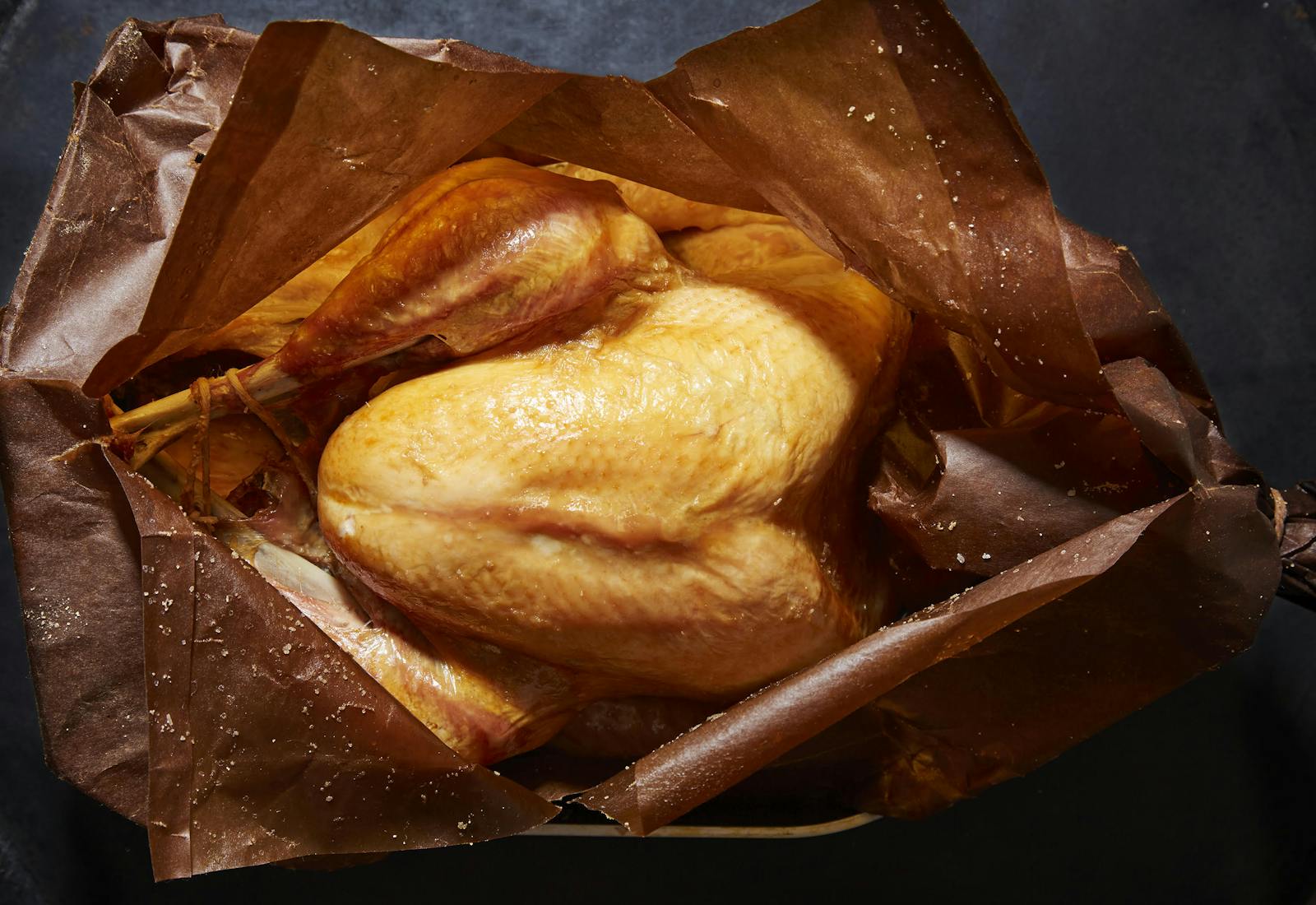
2. Brown Paper Bag Turkey
Yield: 10 - 12 servingsTime: 30min active + 2h to bring turkey to room temp + 3h cooking timeThis recipe was shared by Amanda and Jane Dell. Read more about their family in "The Turkey Recipe One New York Family Will Never Part With."
Ingredients
- 1 - 12-14 lb. turkey, brought to room temperature
- 1-2 cups of canola oil
- Kosher salt (~¼ cup)
- 1 stick (8 tablespoons) unsalted butter, melted*
- 6 tablespoons extra virgin olive oil
- Large brown paper shopping bag without any ink or writing**
Preparation
Step 1
Before getting started it is a good idea to make sure that your turkey fits properly in the brown paper bag you have chosen. This is easier and much less messy when your turkey is still in its package. The turkey should slide easily into the bag and be able to gather and be sealed at the open end of the bag.
Step 2
Two hours before you are ready to cook the turkey, remove it from the refrigerator and let it come to room temperature.
Step 3
Preheat the oven to 375°F.
Step 4
Roll up your sleeves and get ready to get messy! Starting with the outside, completely saturate the paper bag with the canola oil - inside and out. This is best done over or even in the sink, if large enough. The entire bag should look wet, but there should be no pools of oil anywhere. Let the bag sit while you prepare the turkey so that you can make sure that every nook and cranny is completely saturated with oil before adding the turkey. This is very important!
Step 5
Remove any giblets from the cavity and discard or reserve for stock or gravy. Season the entire turkey generously with salt (about 1 teaspoon per pound is a good guideline) rubbing it all over the outside and inside of the bird. Don’t be shy. Really get in there.
Step 6
Using your hands, rub the turkey all over with the unsalted butter and then with the olive oil.
Step 7
Tie the legs of the turkey together with kitchen twine. Slide the turkey inside the paper bag (you will likely need backup for this step) and place the bag on top of a wire rack set in a large roasting pan. Gather the paper bag at the top to close and tie it together with kitchen twine to secure.
Step 8
Punch 8-10 small holes in the top of the bag with a knife to allow for steam to escape
Step 9
Place the turkey in the oven making sure that the oven rack is low enough to accommodate the bag and is not making contact with any of the heating elements inside of the oven. Roast for 2 hours, then cut the top of the bag open to allow for additional browning. Roast for 30-45 minutes more until the juices run clear between the leg and thigh or an instant read thermometer inserted into the thickest part of the thigh reads 165°F. Please note that this is a rough estimate of the amount of time that it will take to cook a 12-14 lb. turkey at 375°F. The final cooking time will depend on many factors including the size of your turkey and the temperature of your oven. A thermometer is the most foolproof way to not overcook your turkey. The important thing here is to cut the bag open when you think you have about 30 minutes of roasting time left so that the bird can get nice and golden and crispy during the final moments of roasting.
Step 10
Let the turkey rest for at least 30 minutes before transferring to a cutting board and carving.
Shared by Chanie Apfelbaum
3. Pomegranate Chuck Roast with Cipollini Onions
Yield: 6-8 servingsTime: 3 ½ hoursShared by Chanie Apfelbaum
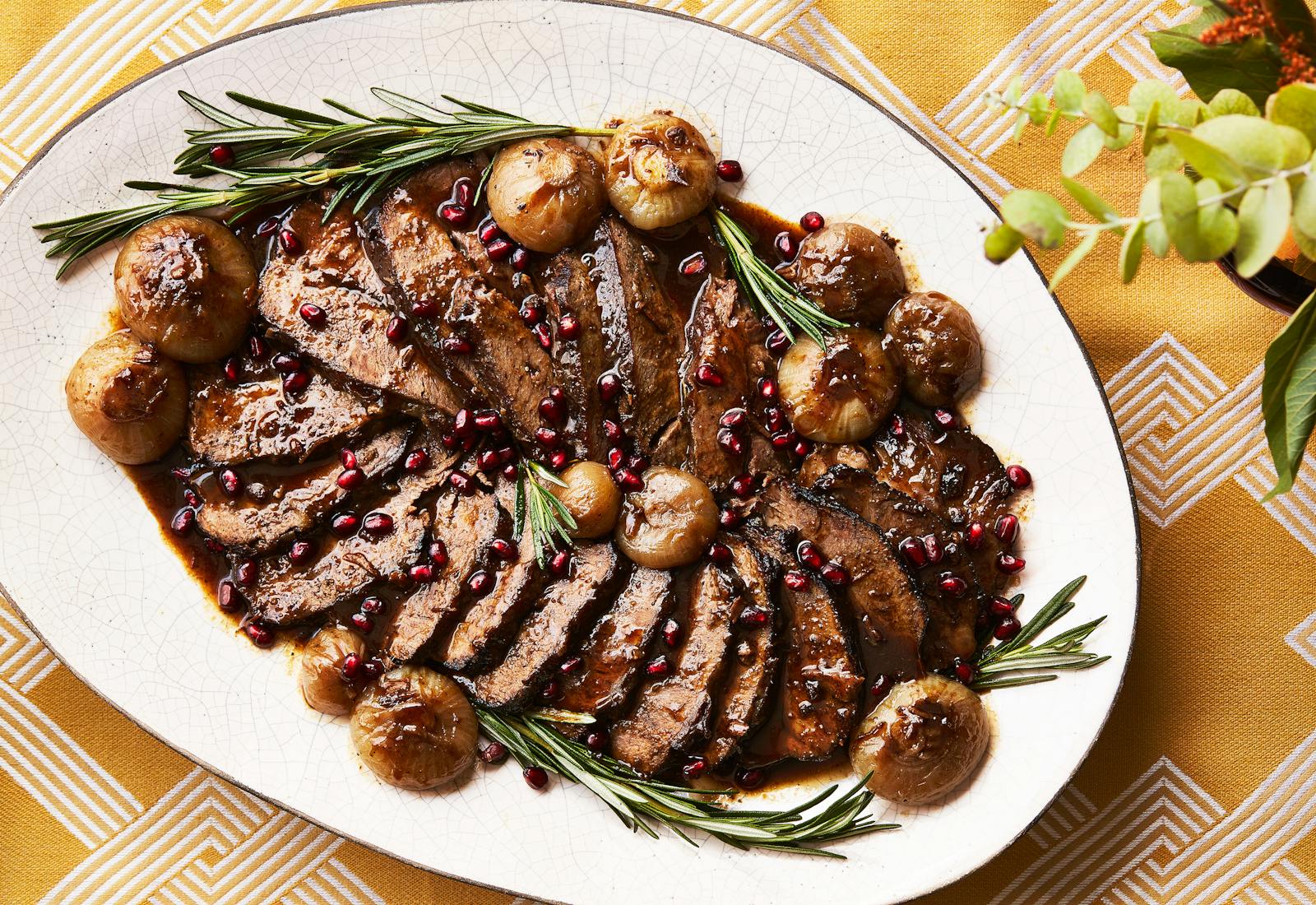
3. Pomegranate Chuck Roast with Cipollini Onions
Yield: 6-8 servingsTime: 3 ½ hoursFlavored with tangy-tart pomegranate molasses and fresh rosemary, this recipe from cookbook author Chanie Apfelbaum yields a perfectly tender roast. Since chuck roast is cut from the shoulder, it can be tougher, which means it benefits from a longer, slower cook time. Be sure to plan ahead.
We love this roast alongside Chanie’s spinach and challah stuffing and Yerushalmi kugel.
Ingredients
- 3-4 lb. chuck roast
- Salt and pepper, to taste
- 2 tablespoons olive oil
- 8 large cipollini onions, peeled
- 10 cloves garlic, peeled and thinly sliced
- 3 sprigs fresh rosemary
- 1 ¼ cups beef stock
- ½ cup pomegranate molasses
- Fresh pomegranate seeds, for serving
Preparation
Step 1
Preheat the oven to 300F. Pat the roast dry; season generously on all sides with salt and pepper. Heat the olive oil in a Dutch oven and sear the roast on all sides until deeply browned. Remove from the pot and set aside.
Step 2
Over medium heat, add more oil if needed and saute the cippolini onions and garlic in the pot, scraping any browned bits, until browned and caramelized in spots. Return the roast to the pot and deglaze with the stock.
Step 3
Add the rosemary and pomegranate molasses to the pot and stir to combine. Season with more salt as needed. Bring the mixture to a boil, cover the pot and bake for 2 hours. Remove from the oven, flip the roast, cover and bake for an additional hour. Remove from the oven.
Step 4
Let the roast cool. Carefully remove from the liquid and slice, transferring to a platter. Strain the liquid into a medium sized saucepan, reserving any cipollini onions and setting them aside.
Step 5
Place the saucepan over a medium-high heat, letting the liquid come to a boil. Let boil, stirring occasionally, until partially reduced and thickened, around 15 minutes. Pour the hot gravy over the sliced roast and garnish with the reserved cipollini onions. Sprinkle with fresh pomegranate arils before serving.
Shared by Becca Gallick-Mitchell
4. Thanksgiving Kreplach
Yield: 35 kreplachTime: 2 h and 30 minShared by Becca Gallick-Mitchell
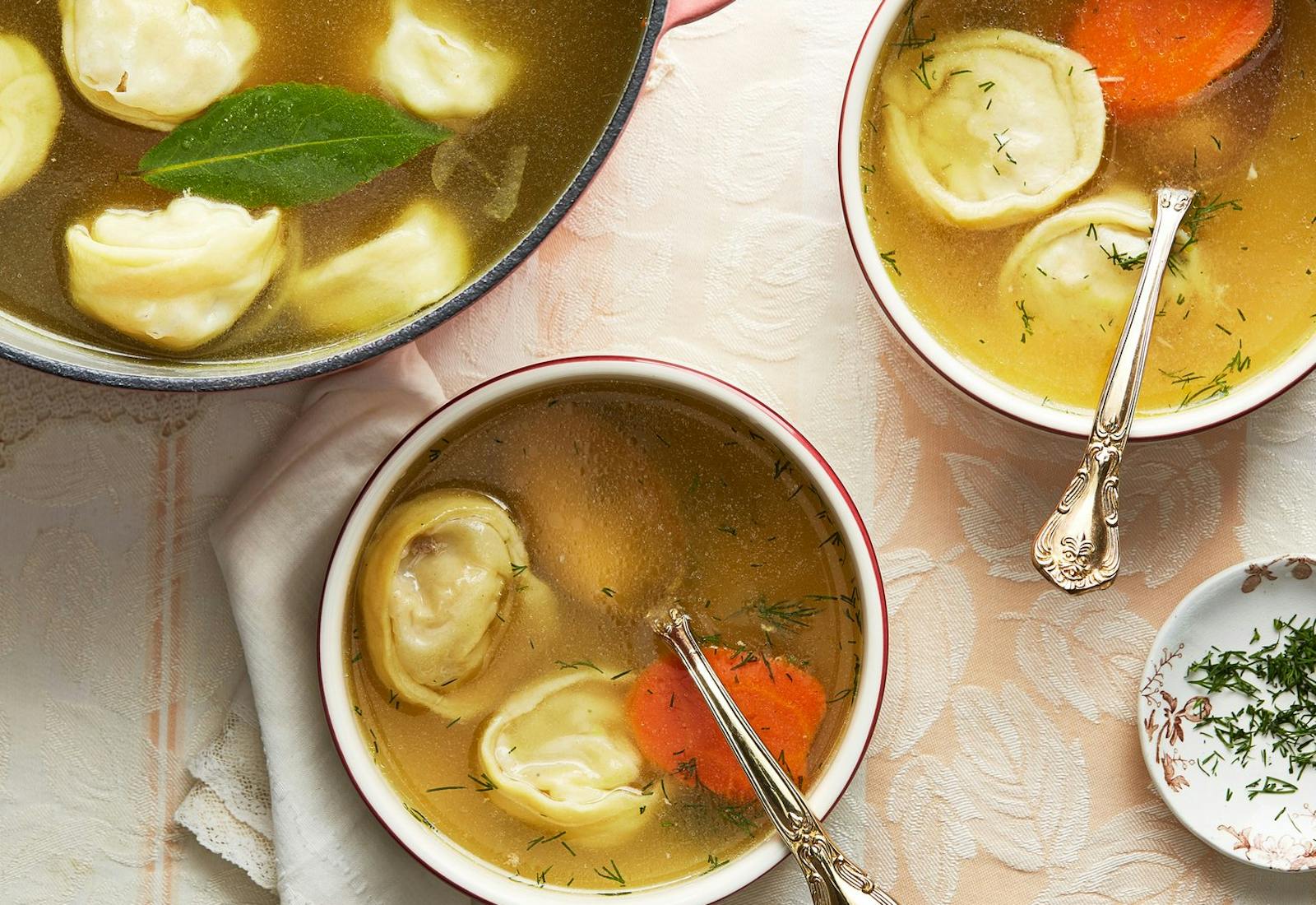
4. Thanksgiving Kreplach
Yield: 35 kreplachTime: 2 h and 30 minIf you are freezing the kreplach, in step #8, transfer the shaped kreplach onto a parchment lined plate and chill for 10 minutes. Then transfer to a bag or container and freeze for up to one month.
This recipe was shared by Becca Gallick-Mitchell. Read more about her family in "A Fifth Generation Thanksgiving Kreplach Tradition."
Ingredients
For the dough
- 1 ¾ cups all-purpose flour
- 1 teaspoon kosher salt
- 2 eggs
- 2 tablespoons water
For the filling and assembly
- 1 tablespoon schmaltz or vegetable oil
- ½ medium onion, roughly chopped
- 2 cloves garlic, roughly chopped
- ½ teaspoon kosher salt
- 1 ½ cups leftover cooked chicken or turkey meat without bones, ideally a mixture of light and dark meat
- ¼ cup packed fresh dill, chopped (optional), plus more for serving
- 2 quarts turkey or chicken broth
Preparation
Step 1
Make the dough: In a large mixing bowl, combine the flour and salt. Add in the eggs and water and incorporate with a fork (or, to avoid cleaning another bowl, you can do this on the countertop by creating a mound with the flour and then making a well for the wet ingredients). Once the dough forms into a ball, knead for about 5 minutes, or until the dough has become soft and elastic. Form it into a smooth ball, and rest under a damp cloth for 30 minutes.
Step 2
Make the filling: Heat the schmaltz in a skillet over medium heat. When it's rippling, add the onion, garlic, and salt, and cook until translucent, 5 minutes. Remove from the heat.
Step 3
In a food processor, combine the turkey or chicken with the onion mixture, making sure to include as much schmaltz as possible. Pulse until well combined. Transfer to a mixing bowl and add the chopped dill, if using, and mix well until fully combined. Cover and chill until ready to assemble.
Step 4
When the dough has rested, begin assembly: divide the dough ball into 4 equal portions. Roll each portion into a ball, keeping the others covered with a towel while you work. Working one at a time, create a hole in the dough ball with your thumbs so that it looks like a bagel. Begin stretching it out the loop of dough until the width of the dough is about ¾-inch thick. Cover the piece of dough with a kitchen towel and repeat this process with the other 3 pieces of dough.
Step 5
Take each dough loop, and cut the loop at two opposite ends so that each dough loop forms two straight logs. Roll each log out with your hands until it is ½ inch thick (width). Cut each log into inch-long pieces and cover with a towel, repeating with all 4 loops.
Step 6
Working one small piece of dough at a time, roll it into a small ball. Using your hands first, then a rolling pin, flatten the dough until it's round and thin, about 2 inches in diameter.
Step 7
Take 1 heaping teaspoon of the filling and place in the center of each dough circle and fold it in half, pinching the edges to seal them well so no filling escapes when they're cooking.
Step 8
Bring the corners of the half-moons together, overlap them a bit and pinch to seal. Repeat with the rest of the dough pieces. Cover and chill until ready to cook.
Step 9
To cook the kreplach, bring a medium saucepan full of salted water to a boil. Drop in your kreplach and stir so that they don't stick to the bottom. Cook for about 3 minutes (or 5 minutes if frozen) until they're al dente.
Step 10
Serve in hot chicken broth with and garnish with more dill (optional).
Shared by Tannaz Sassooni
5. Cranberry Almond Tahdig
Yield: 10 servingsTime: 6 hours (4 hours soaking time)Shared by Tannaz Sassooni
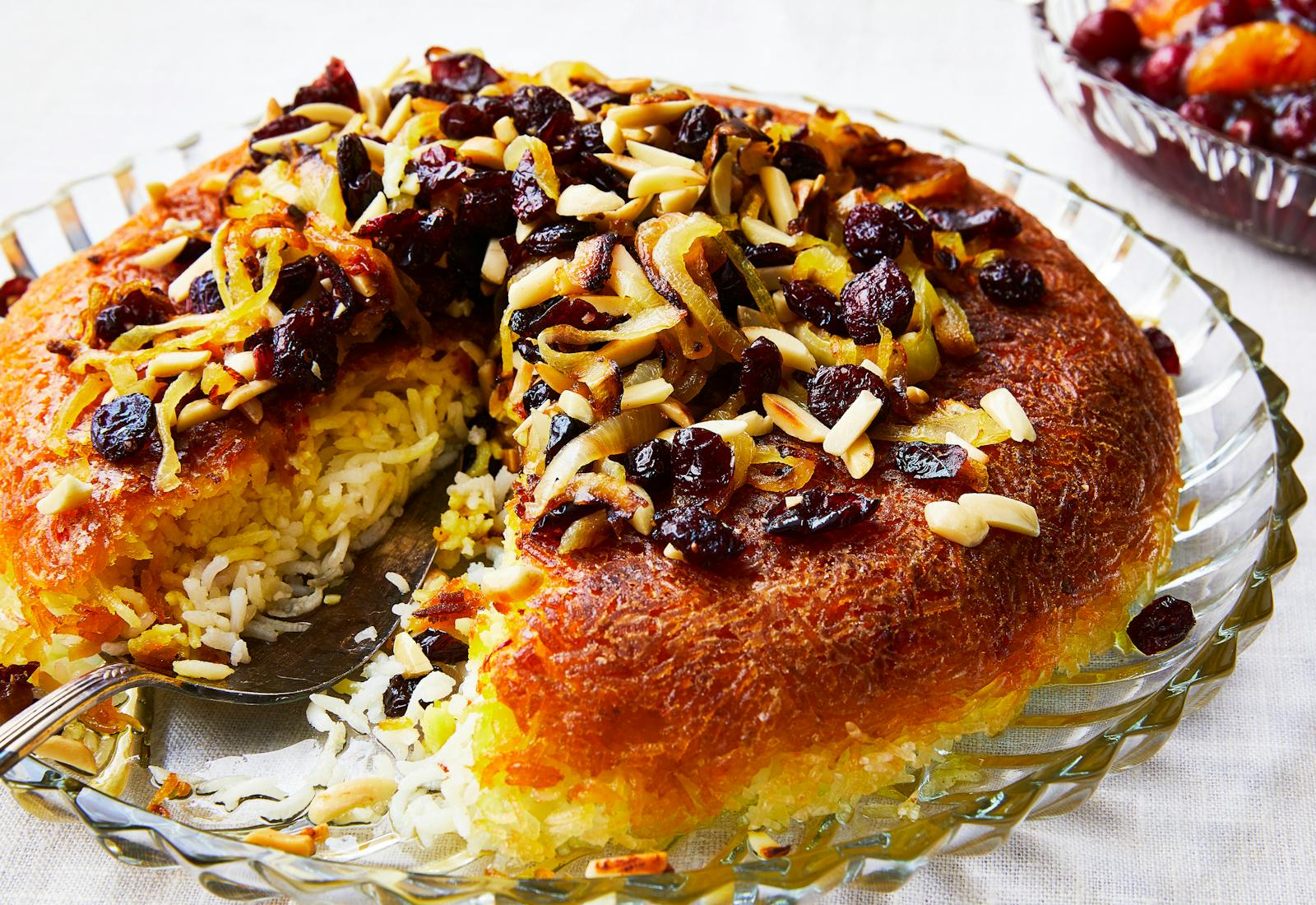
5. Cranberry Almond Tahdig
Yield: 10 servingsTime: 6 hours (4 hours soaking time)Tahchin, a traditional Iranian rice dish, is often confused with tahdig — but it’s quite different, says food writer Tannaz Sassooni. “In Farsi, ‘tah’ means bottom and ‘chin’ means to set,” she explains, adding that tahchin is often made with chicken that’s arranged at the bottom of the pot where it “sets,” and is served as a complete meal.
By contrast, tahdig refers to the crisped rice at the bottom of a pot of rice. This recipe from her family is a blend of these two styles of rice dishes. It’s made by combining egg yolks, lemon juice, and saffron with rice to create a crispy bottom, and it’s topped with caramelized onions, dried cranberries, and toasted, slivered almonds. Savory, crispy, and fluffy in the middle, the tahdig works wonderfully alongside her family’s roasted turkey with saffron and quince.
Read more about Tannaz Sassooni and her family in “How One Iranian Jewish Family Makes Thanksgiving Dinner Their Own” and try her recipes for roast turkey with saffron and quince, cranberry almond tahdig, and sabzi.
Ingredients
- 3 cups good quality, long-grain basmati rice (Tannaz’s family likes Tilda brand)
- 3 ½ tablespoons salt, divided
- 2 egg yolks
- ½ cup + 3 tablespoons grapeseed oil
- Juice of 2 lemons
- ¾ teaspoon ground saffron, divided
- 1 small onion, finely diced
- 1 cup dried cranberries
- 1 cup raw, slivered almonds
Preparation
Step 1
At least an hour and up to five before you plan to serve the tahdig, rinse the rice. Wash the rice three times: Place the rice in a small bowl. Cover with water and stir by clawing through with your fingers. Drain carefully, then repeat this process 2 more times.
Step 2
Cover the entire surface of the rinsed rice with water by about ½”. Add the 3 tablespoons of salt; stir gently to combine. Let sit for at least 1 hour and up to 5.
Step 3
In a large bowl, combine the egg yolks, ½ cup oil, ¼ cup water, lemon juice, and ½ teaspoon of the saffron. Set aside.
Step 4
Bring 5 cups of water to a boil, covered, in a medium non-stick pot over high heat. Carefully add the soaked rice and the water from the bowl. Gently stir through with a spatula, making sure to scrape up the grains at the bottom of the pan. Watch the pot until it comes back to a boil. Lower the flame to medium heat. Leave on medium heat for 3-5 minutes, until the rice is parboiled.
Step 5
Remove from the heat and drain the rice into a large colander. Spread rice gently across the colander's surface to increase surface area and allow it to cool more quickly. Rinse the rice gently with cool water. Rinse and dry the pot.
Step 6
Allow the rice to cool fully, so that it doesn’t cook the egg yolks. Mix ½ of the cold rice with the egg yolk mixture and set aside.
Step 7
In the same pot you used to parboil the rice, add 2 tablespoons of the oil and 2 tablespoons of water. Shake the pot to combine the oil and water and cover the bottom surface of the pot. Add the rice mixed with egg yolks, pressing gently to evenly cover the bottom of the pot. Top with the rest of the rice.
Step 8
Bring the pot to a boil over medium high heat, covered. Lower the flame to low heat and allow the rice to simmer on very low heat for 75 minutes, checking it in the last 20 minutes. If the rice is dry, add a couple tablespoons of water.
Step 9
Meanwhile, make the topping. Add the remaining 1 tablespoon of oil to a large pan over medium heat. Add the onion and remaining saffron and stir to combine evenly. Fry, stirring every couple minutes, until the onion begins to brown, about 5 minutes.
Step 10
Add cranberries and stir to combine. Cook until cranberries darken slightly while the onions continue browning, stirring frequently, about 4 more minutes.
Step 11
Remove cranberry mixture to a bowl and wipe out the pan. In the same pan, toast almonds over medium heat, stirring constantly, until they darken slightly to a toasty golden brown, and you can smell their aroma. Be very careful here — they can burn quickly.
Step 12
To serve, allow rice to cool for a few minutes. Invert the serving platter over the pot, then, holding the serving platter and pot together, swiftly flip the pot, allowing the tahdig to fall into the platter. Top with almonds and cranberry mixture — you can be creative with the design.
Shared by Chanie Apfelbaum
6. Spinach and Challah Stuffing
Yield: one 9x13” pan, 8 servingsTime: 1 ¼ hoursShared by Chanie Apfelbaum
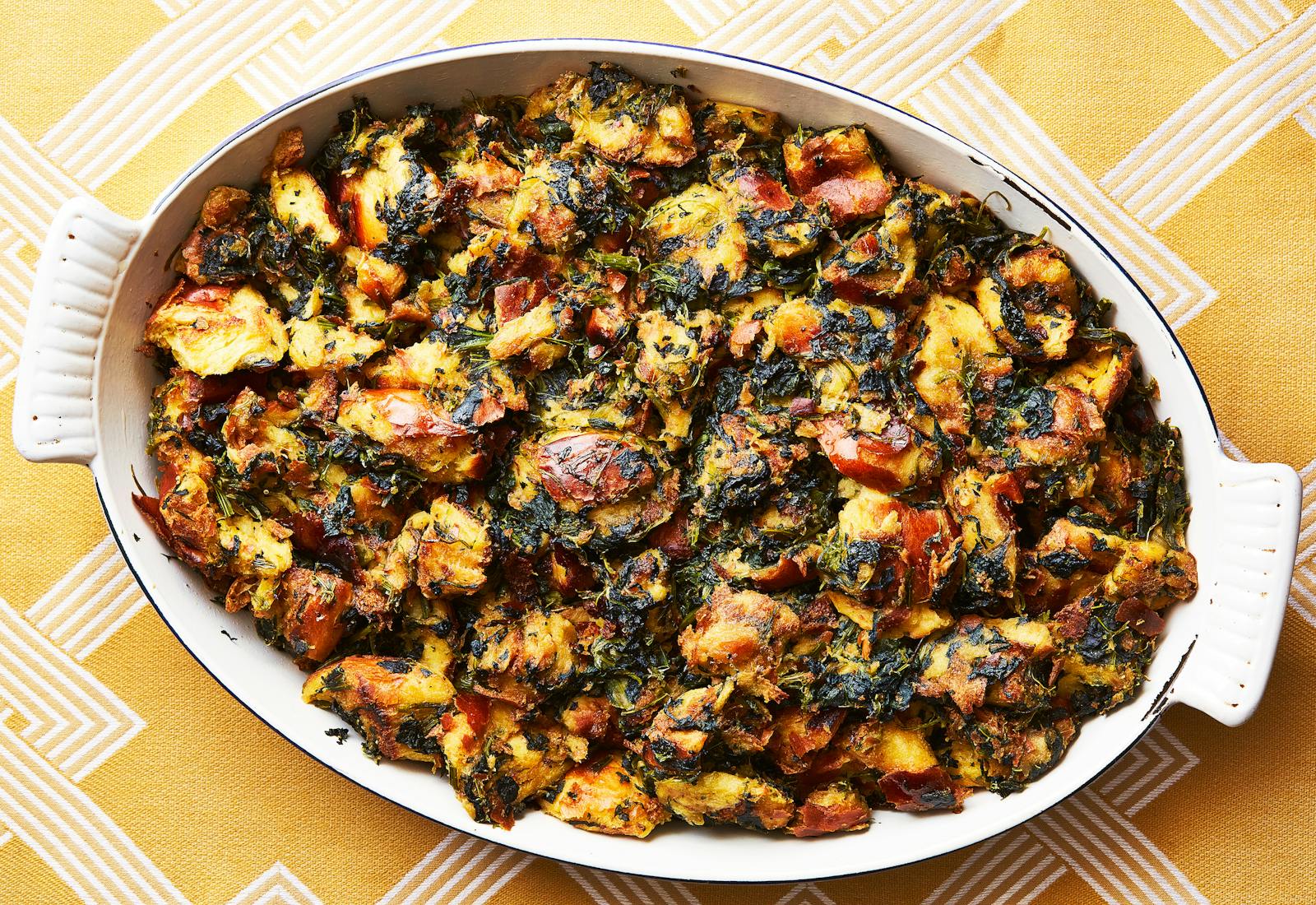
6. Spinach and Challah Stuffing
Yield: one 9x13” pan, 8 servingsTime: 1 ¼ hoursWith a crisp, golden crust and a fluffy, pudding-like interior, this spinach and challah stuffing recipe from Chanie’s mother, Devorah, is a family favorite. Featured in Chanie's bestselling first book, Millennial Kosher, it's the perfect vehicle for soaking up savory pomegranate gravy. Use stale or day old challah for the best results.
Reprinted with the author’s permission.
Read more about the Sukkot traditions that cookbook author Chanie Apfelbaum grew up with in “Cookbook Author Chanie Apfelbaum Brings a Playful Spirit to Sukkot” and find her recipes for apple, honey and fig salad, Yerushalmi kugel, and a marble bundt cake.
Ingredients
- 1 (approx. 20-oz.) large challah, torn into chunks
- 10 oz. frozen chopped spinach, thawed, squeezed of water
- ¼ cup olive oil
- 1 cup chicken stock
- 1 teaspoon poultry seasoning
- Salt and pepper, to taste
Preparation
Step 1
Preheat the oven to 300F. Place the torn challah on a large sheet pan, spreading it out. Bake until dried and lightly golden, around 15 minutes. Remove from the oven and raise the temperature to 350F.
Step 2
Place the challah into a large bowl; add spinach, oil, stock, and poultry seasoning. Season with salt and pepper, then transfer to a lightly oiled 9x13” pan.
Step 3
Cover the pan with foil and bake for 30 minutes. Remove the foil covering and bake for another 10-15 minutes, until the surface is crisp and golden brown. Serve hot.
Shared by Loren Abramovitch
7. Fire-Cooked Sweet Potatoes Stuffed With Sage and Butter
Yield: 4-6 servingsTime: 1 h 30 minShared by Loren Abramovitch

7. Fire-Cooked Sweet Potatoes Stuffed With Sage and Butter
Yield: 4-6 servingsTime: 1 h 30 minThis recipe was shared by Loren Abramovitch. Read more about his family in "A Lag B’Omer Feast From the Lower Galilee" and try his recipes for Fire-Cooked Potatoes Stuffed With Spinach and Cheese, Fire-Cooked Pita Stuffed With Zaatar and Garlic, and Charred Beets With Sour Cream.
Ingredients
- 6 sweet potatoes
- 6 tablespoons unsalted butter, at room temperature
- 1 bunch fresh sage
- Kosher salt
Preparation
Step 1
If not cooking in a fire, preheat the oven to 500 degrees.
Step 2
Slice each sweet potato in half lengthwise. Using a knife, carefully slice 2 small ⅛” trenches along the inside lengths of each sweet potato. On one half of each sweet potato, sprinkle salt, then spread 1 tablespoon of butter across the entire length of the sweep potato. Press 3 sage leaves into the butter. Sprinkle the other half of the sweet potato with salt, and press the halves together to close tightly. Wrap each sweet potato in foil.
Step 3
If cooking with a fire, tuck the potatoes into the bottom center of the bonfire and cook for about 1 hour until charred on the outside and tender on the inside. If using an oven, transfer the potatoes to a sheet tray and roast in the oven for 1 hour and 30 minutes, until fork tender and browned on the outside. Unwrap and serve immediately.
Shared by Mitchell Davis
8. Fermented Vegetable Salad
Yield: 8 servingsTime: 45min active time plus 5 days for fermentationShared by Mitchell Davis
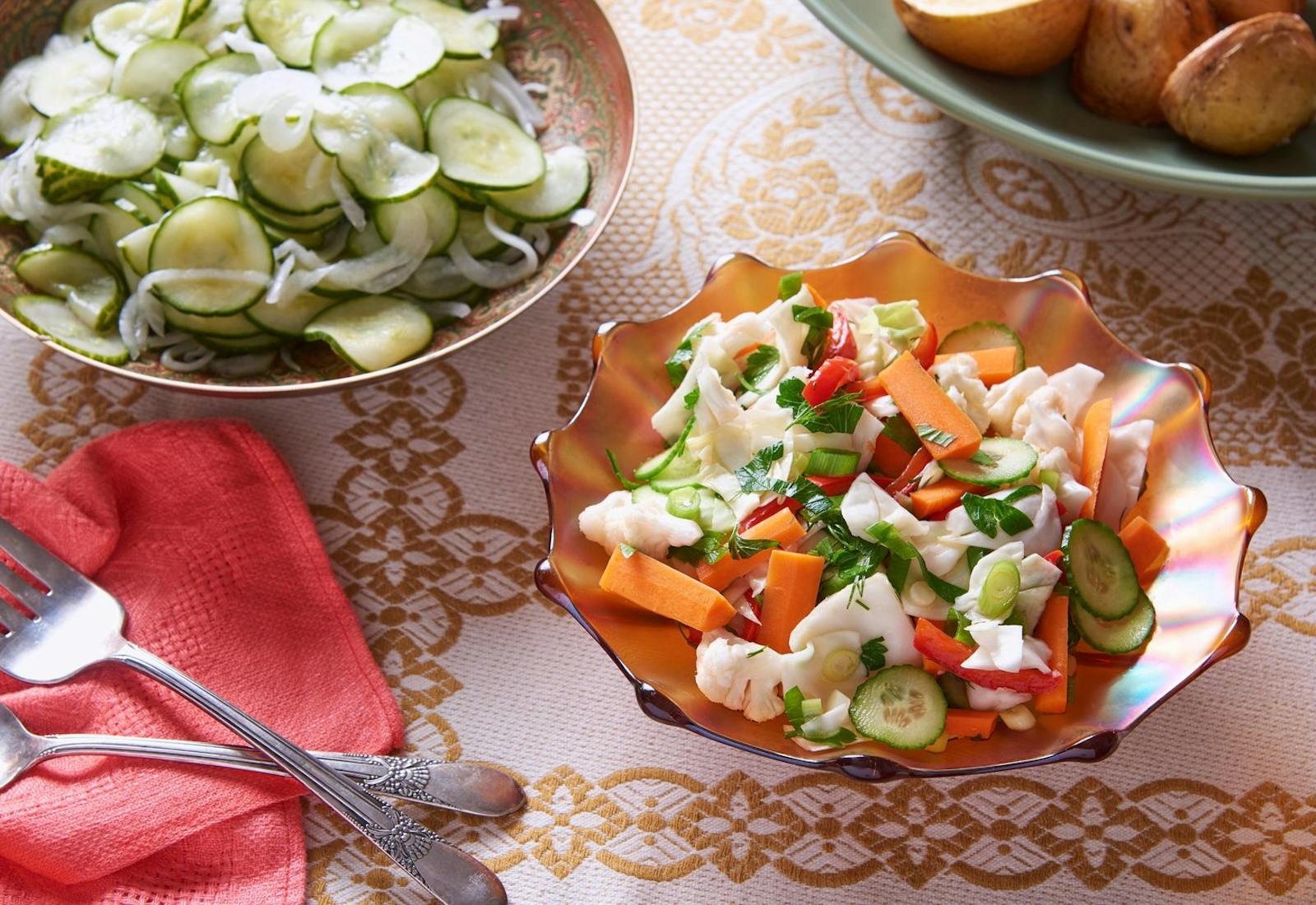
8. Fermented Vegetable Salad
Yield: 8 servingsTime: 45min active time plus 5 days for fermentationThis recipe was shared by Mitchell Davis. Read more about his family in "For Mitchell Davis, the Meal Is the Holiday" and try his recipes for baked fish in sweet and sour sauce, beef brisket, and pickled cucumber salad.
Ingredients
For the vegetables:
- 2 to 3 pounds assorted, hearty vegetables, such as green cabbage, cauliflower, carrots, kohlrabi, daikon, red pepper, or other
- 6 tablespoons kosher salt, plus more as necessary for additional brine
- 10 black peppercorns
- 1 dried hot chili pepper
- 1 teaspoon assorted spices, such as coriander seed, yellow mustard seed, whole star anise, crumpled bay leaf or your favorites
- 2 or 3 Persian cucumbers, thinly sliced
- 1 bunch scallions, white and green parts, sliced, or other onion, such as red or shallot
- 1 small bunch dill and/or a handful of other herbs, roughly chopped
- ⅓ cup olive oil or other vegetable oil
- Apple cider vinegar to taste
- Freshly ground black pepper
Preparation
Step 1
Prepare the vegetables: Slice the cabbage, cut the cauliflower into small florets, peel and slice the carrots, kohlrabi, daikon, slice the pepper, or otherwise prepare whatever you are using. The smaller the pieces the faster they will ferment. Pack the vegetables into lidded nonreactive container(s) (plastic, glass, or ceramic).
Step 2
Make the brine: dissolve the salt into 2 cups of water that you heat in 1 minute intervals in the microwave or over the stove. Once the salt is dissolved, add 6 cups cold water to cool the brine to room temperature. Add the peppercorns, chili pepper, and spices.
Step 3
Pour the brine over the vegetables to cover. If you need more brine, make it in the same ratio by dissolving 3 tablespoons of salt into 1 quart (4 cups) of water. Cover the container(s) and let sit at room temperature for 2 to 5 days to ferment until the desired doneness. Open the containers at least once each day to release any gas that builds up (called “burping”). I like to taste them each day so I know how the flavor is progressing. On the first day you won’t see any change. On the second day you might see some bubbles. By the third day there will be more evidence of fermentation. Bubbles, a distinct smell, and the brine will begin to get cloudy. Some gunk may form on the top. Don’t worry about this. It is normal.
Step 4
When the vegetables have reached their desired doneness—a good tang, maybe even a little fizz—it’s time to stop the fermentation - lift the vegetables out of the brine and rinse with cold water. Place in a clean container. Strain the brine over the vegetables and refrigerate until ready to use. (Chef’s note: Save the brine to use it for subsequent batches of pickles. It can be used up to five additional times and can also be used to cook with. You can add it to salad dressings, some soups, savory baked goods and other condiments, the way you might use miso or soy).
Step 5
To assemble the salad: combine the fermented vegetables. Add the cucumber, scallions, dill, herbs, if using, and olive oil. Toss and taste. Adjust the acidity with vinegar if necessary, and season with pepper. The salad will keep two or more weeks in the fridge.
Shared by Rachel Simons
9. Fennel and Herb Salad
Yield: 4 servingsTime: 30 minShared by Rachel Simons
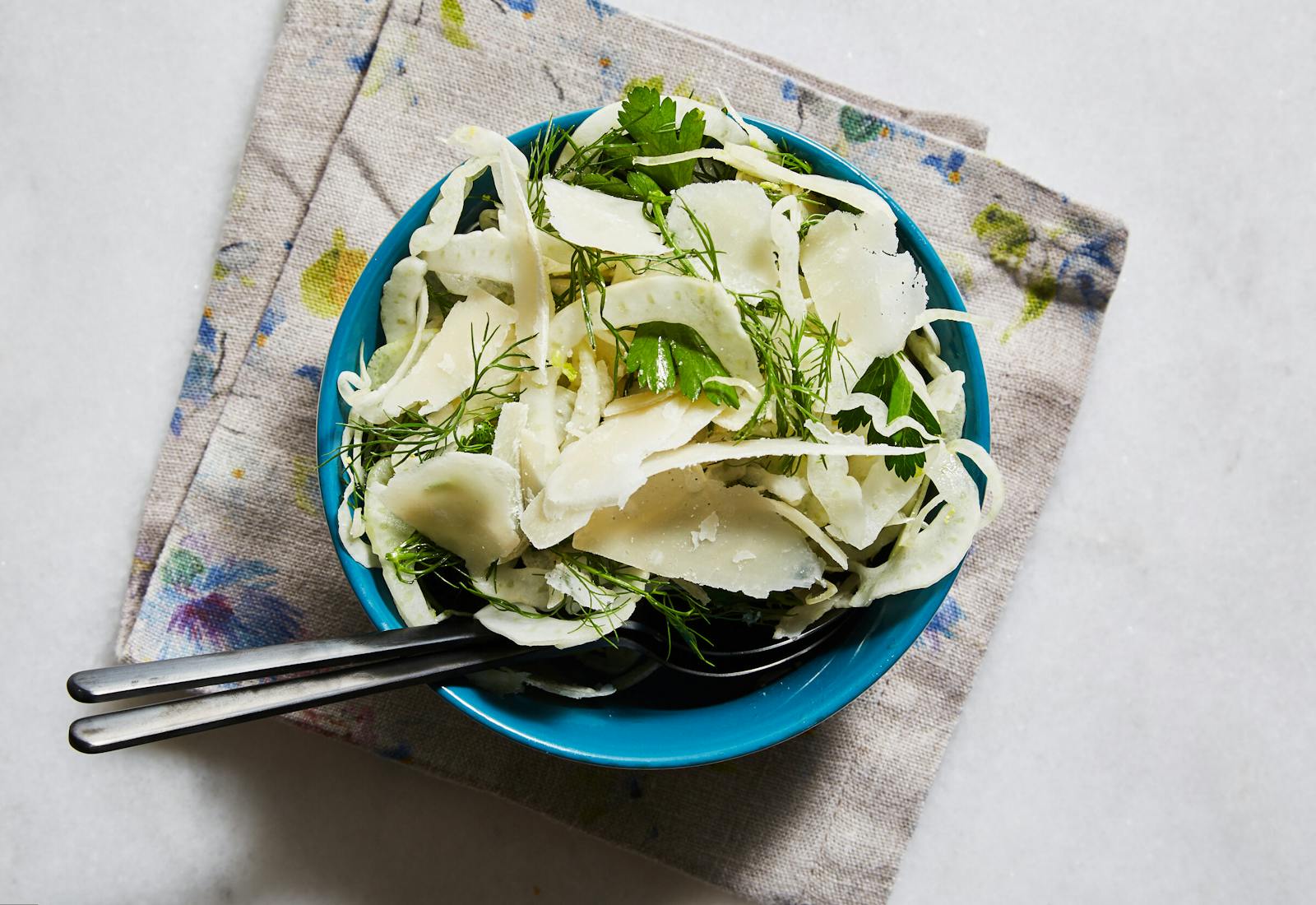
9. Fennel and Herb Salad
Yield: 4 servingsTime: 30 minThis recipe was shared by Rachel Simons. Read more about her family in "A Schnitzel Recipe That’s Traveled to Hong Kong, London, New York, and Beyond" and try her recipes for schnitzel with cherries, crispy smashed potatoes, and chocolate tahini truffles.
Ingredients
- 1 fennel bulb, very thinly sliced crosswise
- Juice of 1 lemon
- 1 cup cold water
- ½ cup fresh mint leaves, roughly chopped
- ½ cup fresh parsley leaves, roughly chopped
- 1 tablespoon white wine vinegar
- 2 tablespoons extra virgin olive oil
- 1 teaspoon flaky sea salt
- ⅛ teaspoon ground black pepper
- 1 cup parmesan cheese, thinly shaved (optional)
Preparation
Step 1
Place the sliced fennel into a bowl with the lemon juice and cold water. Let sit for about 10 to 15 minutes. Drain the fennel.
Step 2
In a large bowl, mix the fennel, mint leaves, parsley leaves, white wine vinegar, olive oil, salt, pepper and parmesan (if using). Mix to combine well.
Step 3
Serve the salad cold.
Shared by Rottem Lieberson
10. Red Cabbage, Date, and Beet Salad
Yield: 4 to 6 servingsTime: 1 h 15 minShared by Rottem Lieberson
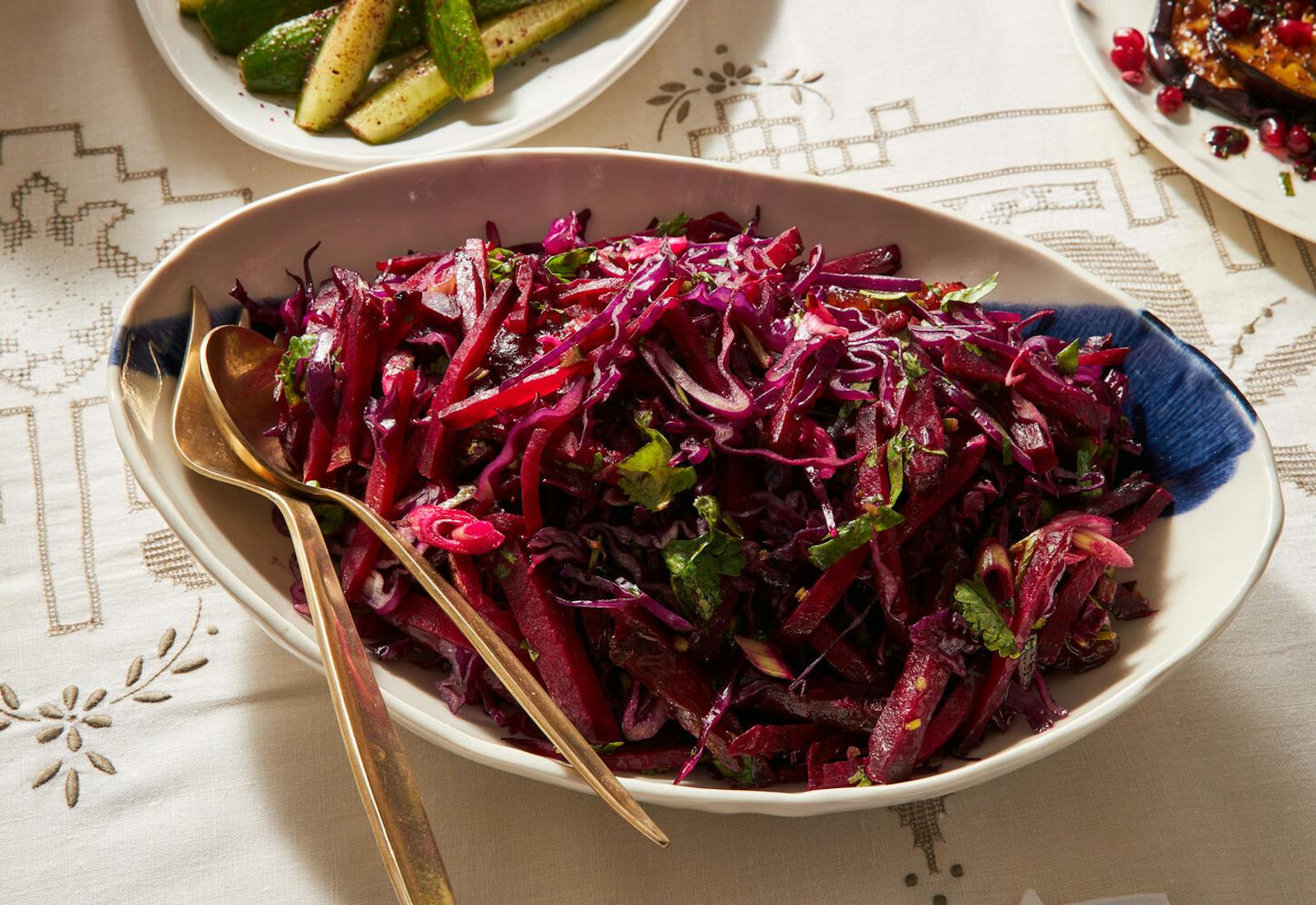
10. Red Cabbage, Date, and Beet Salad
Yield: 4 to 6 servingsTime: 1 h 15 minThis recipe is featured in our cookbook "The Jewish Holiday Table: A World of Recipes, Traditions & Stories to Celebrate All Year Long." For more holiday recipes from around the world, get your copy!
Read more about Rottem's family in "A Persian Grandmother and Her Secret Rosh Hashanah Recipes" and try her recipes for olive salad with pomegranate, khoresh sib (lamb stew with quince and dried apricot), and ashe anar (pomegranate soup with meatballs).
Ingredients
- 4 large beets
- ½ red cabbage, cored and thinly sliced crosswise
- 5 dried dates, pitted and thinly sliced lengthwise
- 1 jalapeño pepper, finely chopped (optional)
- ⅓ cup fresh cilantro or scallions, finely chopped
- 1 teaspoon salt
- 1 tablespoon olive oil
- Juice from 1 lemon
Preparation
Step 1
Preheat the oven to 395 degrees. Meanwhile, line a baking sheet with parchment paper.
Step 2
Place the beets onto the baking tray and bake for about 40 minutes, until fork tender. Cool the beets for about 20 to 30 minutes until easily handled. Peel the beets and discard the peels. Julienne the beets, cutting them into 2 inch slices that are ⅛-inch thick.
Step 3
Place the beets, cabbage, dates, jalapeño (if using) and cilantro or scallions, salt, olive oil and lemon juice into a bowl and mix well. Taste and adjust the seasoning as needed. Serve immediately.
Shared by Frida Goldberg and Mimi Bozo
11. Faulle (Stewed Green Beans With Beef)
Yield: 6 servingsTime: 30 min active + 3 h and 15 min inactiveShared by Frida Goldberg and Mimi Bozo

11. Faulle (Stewed Green Beans With Beef)
Yield: 6 servingsTime: 30 min active + 3 h and 15 min inactiveAdelle always sliced the green beans lengthwise, which helps them melt into the rich sauce. If you are shorter on time, you can also leave them whole.
This recipe was shared by Frida Goldberg and Mimi Bozo. Read more about their family in "How One Cook, Who Knew No One, Built a Syrian Community Around the Table" and try their recipes for roasted eggplant salad, chicken with 'chips', and bulgur muhammara.
Ingredients
- 3 tablespoons vegetable or olive oil
- 1 pound beef shoulder center cut, cut into 2-inch cubes
- 2 teaspoons kosher salt, divided
- 2 ½ pounds green beans, trimmed
- 3 tablespoons tomato paste
- ½ teaspoon cinnamon
- ½ teaspoon ground black pepper
Preparation
Step 1
In a large pot or dutch oven, heat oil over high heat until it shimmers. Add the beef cubes and sprinkle with 1 teaspoon of salt. Cook until nicely browned on all sides, 10 minutes.
Step 2
Add 3 ½ cups of water into the pot. Bring to a boil, then reduce to a simmer, cover, and cook for 1 hour.
Step 3
Add the green beans, tomato paste, the remaining 1 teaspoon salt, cinnamon, and black pepper. Simmer for an additional 2 hours, until the meat and beans are falling apart, and the liquid has reduced to a thick sauce. Taste and adjust seasoning.
Step 4
Serve hot.
Shared by Michael Twitty
12. Koshersoul Collards with Horseradish
Yield: 6-8 servingsTime: 1 hourShared by Michael Twitty
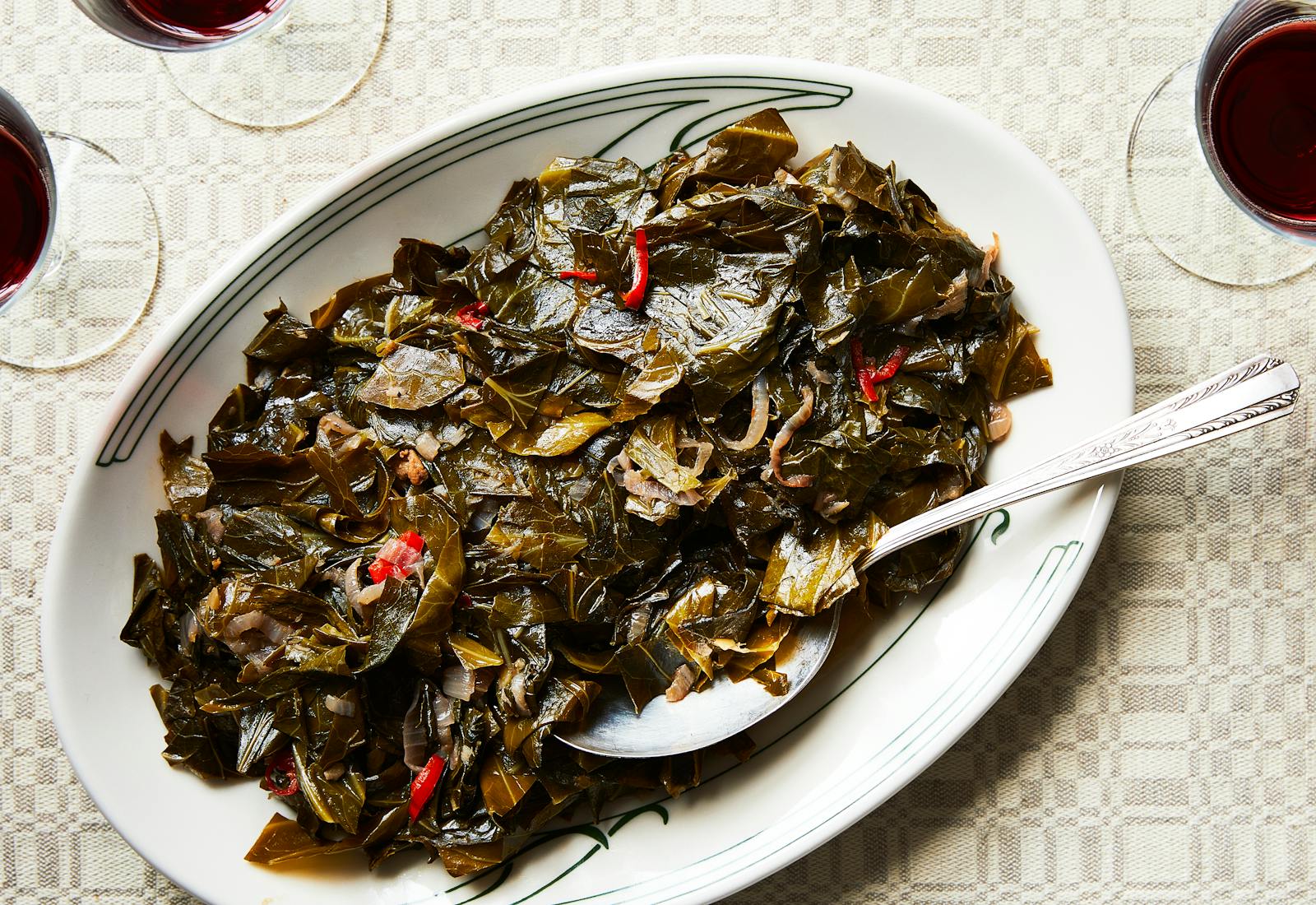
12. Koshersoul Collards with Horseradish
Yield: 6-8 servingsTime: 1 hourFor cookbook author and culinary historian Michael Twitty, collard greens are a constant on the table. While often made with ham hocks, Michael’s collards are kosher, and get their flavor from spicy cayenne and bright lime. Come Passover, Michael adds horseradish to his collards, lending a taste of the holiday to the dish. Serve the collards alongside his West African Brisket and Yassa sauced Kneidlach.
Read more about Michael Twitty’s Passover celebrations in “For Michael Twitty, Seder Is a Chance to Share His Origin Story with Chosen Family.”
Ingredients
- ¼ cup schmaltz
- 1 large red onion, thinly sliced
- 1 long red cayenne pepper, sliced into thin rings
- 1 clove minced garlic
- 1 teaspoon fresh ginger, minced
- 1 tablespoon chicken consomme powder
- 4 lbs. collards, stemmed, trimmed and cut into long, thin strips
- 3 cups vegetable stock
- 2 tablespoons lime juice
- 2 tablespoons horseradish
- 2 teaspoons coconut sugar
- 1 teaspoon smoked paprika
Preparation
Step 1
Heat schmaltz in a large pot over medium heat for one minute; after a few minutes, toss in the onion slices and let them sweat.
Step 2
Add the red pepper, garlic, ginger, and consomme powder and slowly sweat on low heat for 10 minutes, stirring occasionally. Raise the heat to medium high.
Step 3
Add the thin strips of collard greens handful by handful, stirring as necessary. With each batch of three handfuls, cook the collards for about 5 minutes.
Step 4
When all of the collards have been incorporated, add the vegetable stock. Bring to a boil, then lower the heat to a simmer.
Step 5
Add the lime juice, coconut sugar, and smoked paprika. Stir, cover and cook on a low simmer for 45 minutes. Remove the collards with a slotted spoon and serve.
Shared by David Glick
13. Yapsuk (Potato Kugel)
Yield: 6 - 8 servingsTime: 2h 30minShared by David Glick
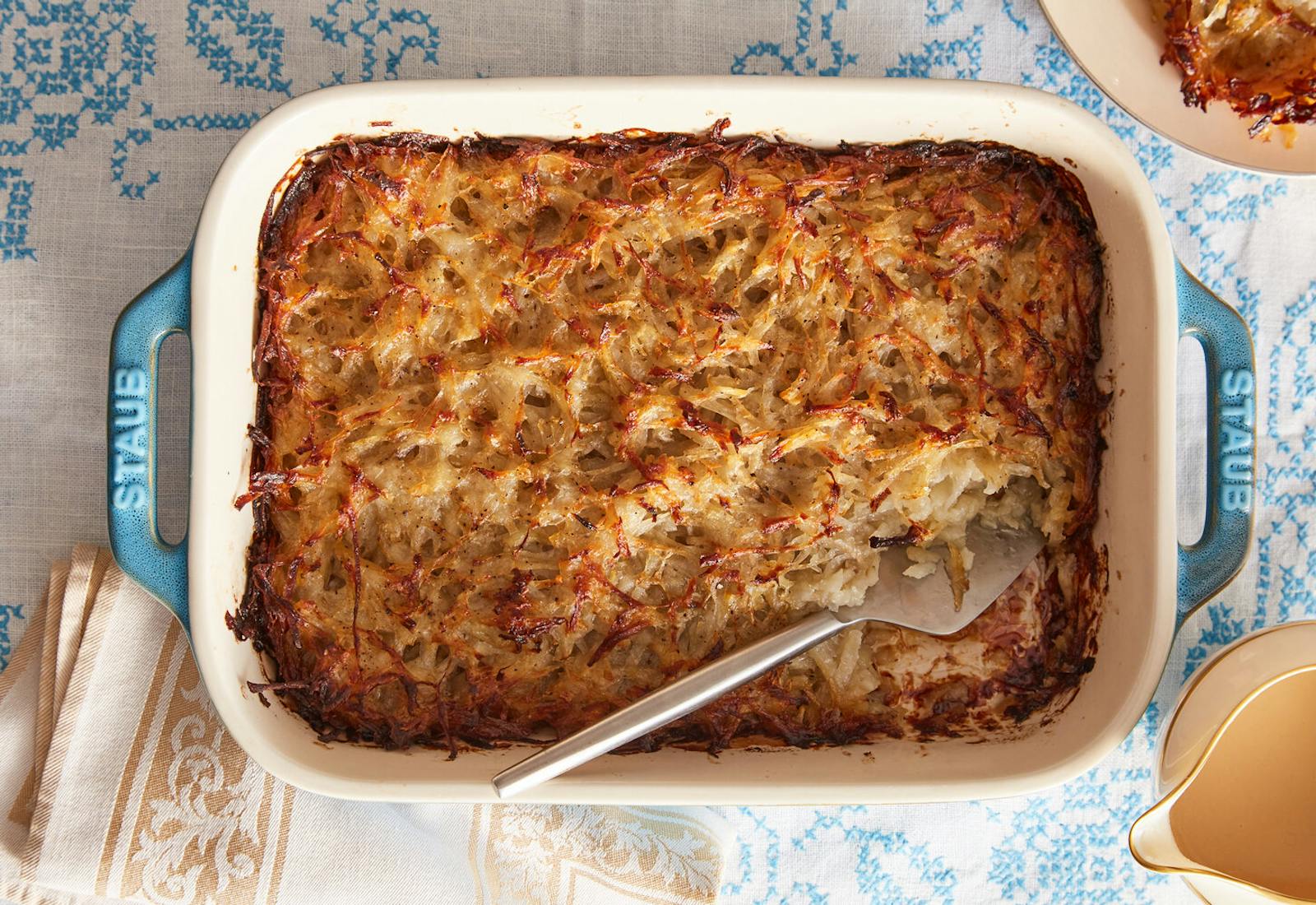
13. Yapsuk (Potato Kugel)
Yield: 6 - 8 servingsTime: 2h 30minThis recipe was shared by David Glick. Read more about his family in "How Gussie’s Yapsuk Became a Thanksgiving Favorite."
Ingredients
- 5 lbs Idaho potatoes (about 8 to 10 potatoes), peeled
- 1 large onion, peeled
- 1 cup + 1 tablespoon vegetable oil
- 4 ½ tablespoons breadcrumbs
- 2 teaspoons salt
- ¼ teaspoon ground black pepper
Preparation
Step 1
Preheat oven to 350 degrees.
Step 2
Grate the potatoes and onion into a large bowl.
Step 3
Pour 1 cup of vegetable oil, breadcrumbs, salt and pepper into the potato and onions. Mix to combine well.
Step 4
Grease a 9 x 13 inch casserole dish with 1 tablespoon of vegetable oil.
Step 5
Evenly place the yapsuk mixture into the casserole dish. Cover the dish with aluminum foil and bake for 40 minutes. Remove the yapsuk from oven and raise the temperature to 400 degrees. Uncover the yapsuk and transfer it back into the oven for 1 to 1 ½ hours until the potatoes are cooked through and the edges of the yapsuk are a deep golden brown.
Step 6
Serve hot with a side of gravy.
Shared by Tsivia Tobi
14. Mashed Pumpkin
Yield: 8 - 10 servingsTime: 30minShared by Tsivia Tobi
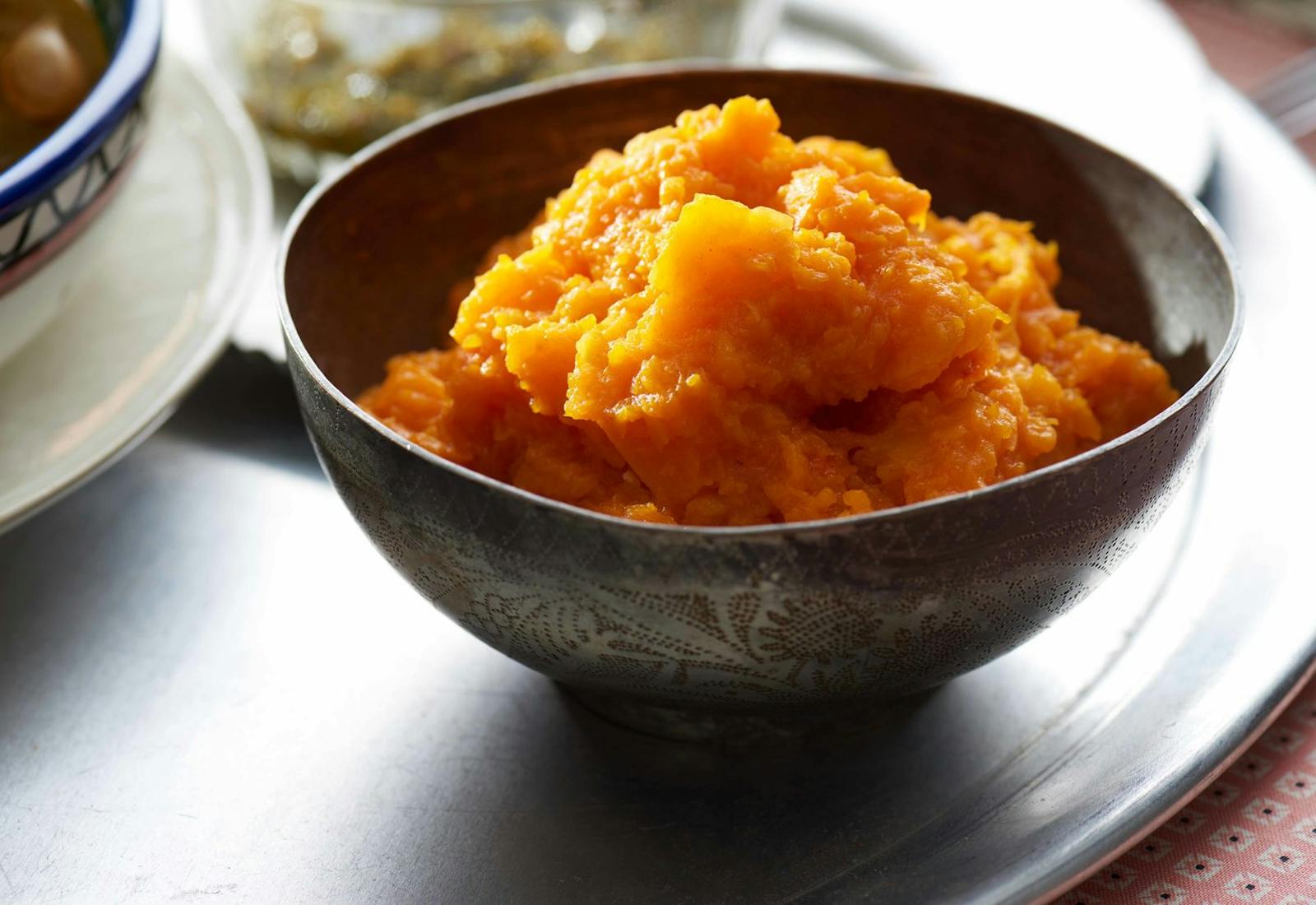
14. Mashed Pumpkin
Yield: 8 - 10 servingsTime: 30minThis recipe was shared by Tsivia Tobi. Read more about her family in "Keeping a Couscous Tradition Alive — Even When There’s No Couscous in Sight" and try her recipes for merget kaski (vegetable soup with bulgur), kofta (meat patties), and turshi (pickled vegetables).
Ingredients
- 2 pounds peeled and seeded pumpkin/winter squash, such as butternut or kabocha, cut into 1” chunks
- ½ cup of fresh lemon juice
- 1 tablespoon olive oil
- 1 large or 2 small cloves garlic, grated
- 1 teaspoon salt
- 1 teaspoon paprika
Preparation
Step 1
In a medium pot, bring 2 quarts of water to a boil. Add pumpkin and cook until soft, about 15 minutes.
Step 2
Drain water from pumpkin, transfer to a large bowl and let cool for 10 minutes.
Step 3
Add the lemon juice, olive oil, garlic, salt and paprika and mash together using a fork or potato masher until smooth.
Step 4
Serve room temperature or chilled with Merget Kaski & Kofta.
Shared by Alona Eisenberg
15. Chudo (Kavkazi Flatbread Stuffed With Pumpkin)
Yield: 6 - 8 servingsTime: 1h plus 1h30min for rising or overnightShared by Alona Eisenberg
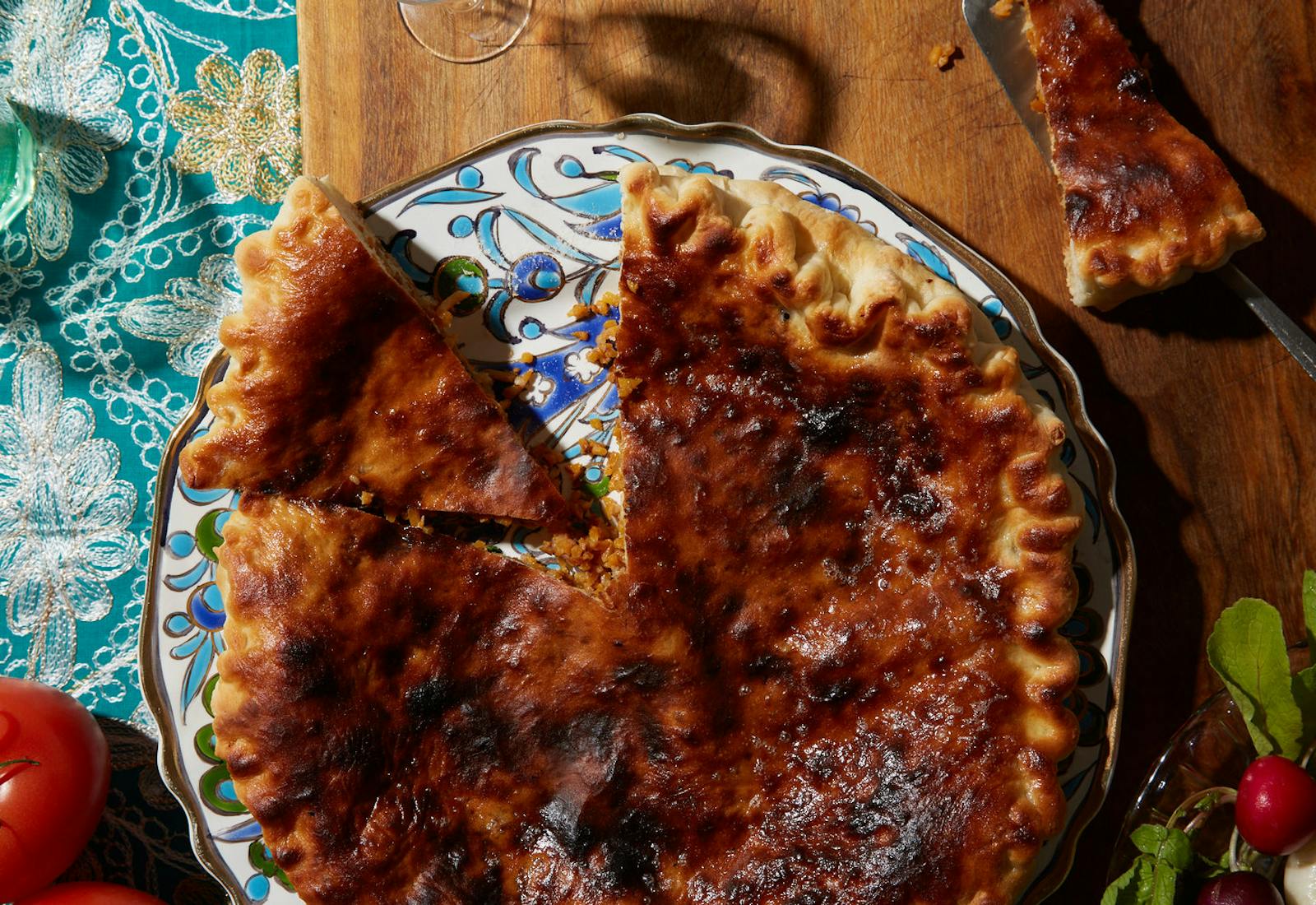
15. Chudo (Kavkazi Flatbread Stuffed With Pumpkin)
Yield: 6 - 8 servingsTime: 1h plus 1h30min for rising or overnightThis recipe was shared by Alona Eisenberg. Read more about her family in "Finding a Route to the Kavkaz Mountains in the Kitchen" and try her recipes for pasta with walnut sauce and beef filled dumplings.
The pumpkin and walnut filling is unique, and can be made dairy-free, parve and vegan when omitting the butter.
Other fillings include:
Ground beef or lamb with various chopped green herbs (This version is done with no top dough round, just the bottom dough round and the meat mixture on top, like pizza or lahmajun): 1 ¾ pounds ground beef or lamb, ¼ bunch chopped cilantro, 1 grated plum tomato, kosher salt and pepper, to taste. Mix the filling ingredients and divide between each thinly rolled dough half, leaving a wide 2- to 2 ½-inch rim. Fold the edges up over the filling as you would a galette, to keep the juices in.
Mixed greens: 1 package fresh spinach, 1 bunch celery leaves, ¼ bunch each of parsley, cilantro, dill and mint. Chop the greens and herbs, mix, and season with kosher salt and freshly ground black pepper for a parve version, or with ⅔ pound Tvoro cheese or Bulgarian feta for the dairy version. Roll and fill the dough as directed.
Ingredients
For the dough:
- 1 pound (3⅓ cups) all-purpose flour, plus more for dusting
- 2 tablespoons canola oil
- 1 teaspoon active dry yeast
- 1 teaspoon sugar
- 1 teaspoon kosher salt
- 1½ to 1¾ cups lukewarm water
For the filling:
- 4 tablespoons unsalted butter (or canola oil for a parve or dairy-free version)
- 2 tablespoons canola oil
- ¼ teaspoon whole cumin seeds
- 2 pounds peeled and coarsely grated (about 8 cups) fresh pumpkin (or butternut squash if fresh pumpkin is unavailable)
- 3 ounces (⅔ cups) shelled walnuts, finely ground in a food processor
- Kosher salt, to taste
- Freshly ground black pepper, to taste
- 2 tablespoons unsalted butter, melted, for brushing (or canola oil for a parve version)
Preparation
Step 1
Make the dough: Combine all the ingredients in a mixer bowl equipped with the hook attachment. Mix until the dough comes together and pulls away from the sides of the bowl, 4 to 5 minutes. Cover the bowl with plastic wrap or a damp towel and place in a warm place until the dough has doubled in size, 1½ to 2 hours.
Step 2
Meanwhile, make the filling: Melt the butter and oil in a large skillet over medium-high heat. Add the cumin seeds and toast until fragrant, about 1 minute. Add the grated pumpkin, spread evenly in the pan and sauté, stirring occasionally, until the liquid evaporates, 5 to 7 minutes. Add the ground walnuts, salt and pepper to taste, and mix well. Transfer to a bowl, loosely cover and refrigerate until cool, about 1 hour.
Step 3
To make the flatbreads: Preheat the oven to its maximum temperature, 500°F to 520°F, with a pizza stone or upside-down sheet pan placed on a rack in the lower third of the oven to heat. Move the risen dough to a large, lightly floured work surface. Knead just to form into a ball,1 to 2 times. Divide the dough in half with a dough cutter. Keep one half covered while working with the other half.
Step 4
Divide one half of the dough into one-third and two-thirds segments. Pat the two-thirds piece of dough into a round and roll out as thinly as possible without tearing, dusting generously with more flour as needed. The dough should be especially thin at the edges, to avoid a thick seam where the two pieces of dough are joined around the filling. Carefully move the larger dough round onto a large sheet of parchment paper and set aside. Form the smaller third into a round on the floured surface and roll out as thinly as possible.
Step 5
Spread half of the pumpkin filling evenly over the larger circle, leaving a wide rim (about 1 to 1½ inches) around the edge. Place the smaller dough round on top of the filling (it will not cover it completely) and flatten gently with your fingers to push out air bubbles.
Step 6
Begin crimping the two edges of the dough rounds together in a classic Kavkazi braid pattern by bringing the inner round towards the outer with your index finger and the outer round towards the inner with your thumb, and lightly pinching them together. With your other hand, continue to pull the outer circle of dough inwards and turn the parchment as you advance, creating a tightly sealed seam around the filling.
Step 7
Carefully slide the parchment with the filled flatbread onto the baking stone or sheet in the oven. Bake until puffed and golden brown, 8 to 10 minutes. Remove and immediately brush with the melted butter or oil. Let cool slightly before cutting into wedges.
Step 8
Meanwhile, repeat steps 4 through 7 with the remaining half of the dough and filling.
Alternative folding technique: Starting from step 3, roll out each half of the dough into a large, thin round. Divide the filling between the rounds, leaving a wide 2- to 3-inch rim on each. Pull the edges of the dough towards the center of each round over the filling and pinch firmly to seal. Flip the filled flatbreads over seam-side down onto pieces of parchment paper and bake as instructed.Step 9
Shared by Erin Gleeson
16. Kale Hazelnut Salad
Yield: 2 servingsTime: 15minShared by Erin Gleeson
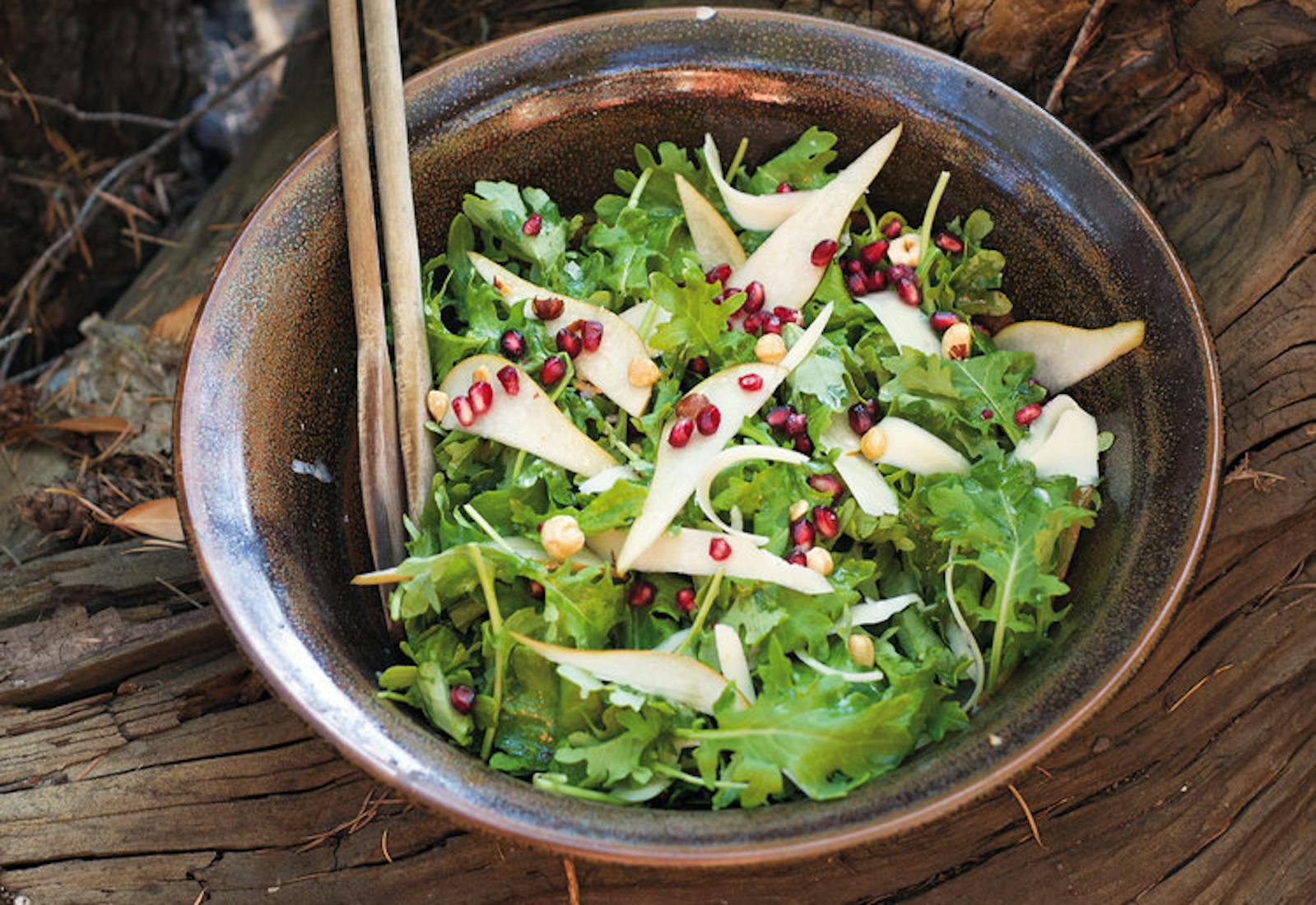
16. Kale Hazelnut Salad
Yield: 2 servingsTime: 15minThis recipe was shared by Erin Gleeson. Read more about her family in "The Challah from a Cabin in the California Woods" and try her recipes for carrot salad with chickpeas, quinoa, and pepitas, sesame farro salad, and challah.
Ingredients
- 2 pears, thinly sliced
- ¾ cup hazelnuts, chopped
- 8 small handfuls of baby kale, mixed greens or arugula
- Seeds from 1 pomegranate
- 4 oz. shaved hard pecorino
Erin’s Favorite Vinaigrette:
- ¾ cup olive oil
- ¼ cup balsamic vinegar
- 2 teaspoons soy sauce or Braggs aminos
- 2 teaspoons toasted sesame oil
Preparation
Step 1
Up to an hour before serving, place kale in a big bowl and toss with your favorite vinaigrette.
Step 2
Scatter all other ingredients on top of the greens so they are visible, mixing just a bit in.
Step 3
Drizzle a little more dressing over the top.
Shared by Tannaz Sassooni
17. Pomegranate-Lime Tequila Spritzer
Yield: 4 servings, easily doubledTime: 5 minutesShared by Tannaz Sassooni

17. Pomegranate-Lime Tequila Spritzer
Yield: 4 servings, easily doubledTime: 5 minutesWhen Tannaz Sassooni’s family gathers for Thanksgiving, they make a big pitcher of this festive spritzer. Simple and refreshing, the tart pomegranate and lime make this the perfect aperitif to serve to your guests before sitting down for dinner. Use a good quality sparkling water for best results.
Read more about Tannaz Sassooni and her family in “How One Iranian Jewish Family Makes Thanksgiving Dinner Their Own” and try her recipes for roast turkey with saffron and quince, cranberry almond tahdig, and sabzi.
Ingredients
- 1 ⅓ cups pomegranate juice
- 2 large limes, juiced
- 6 oz. white tequila
- 1 cup sparkling water
- Pomegranate seeds and lime wedges, for serving
Preparation
Step 1
Add the pomegranate juice, lime juice, and tequila to a cocktail shaker filled with ice. Shake vigorously, then divide and pour into 4 glasses. Top each glass with ¼ cup of sparkling water. Garnish with pomegranate seeds and lime wedges. Serve.
Shared by Anna + Claude Polonsky
18. Strudel Aux Pommes (Apple Strudel)
Yield: 8 servingsTime: 1h 40 min or 2h 40 min (if preparing dough from scratch)Shared by Anna + Claude Polonsky
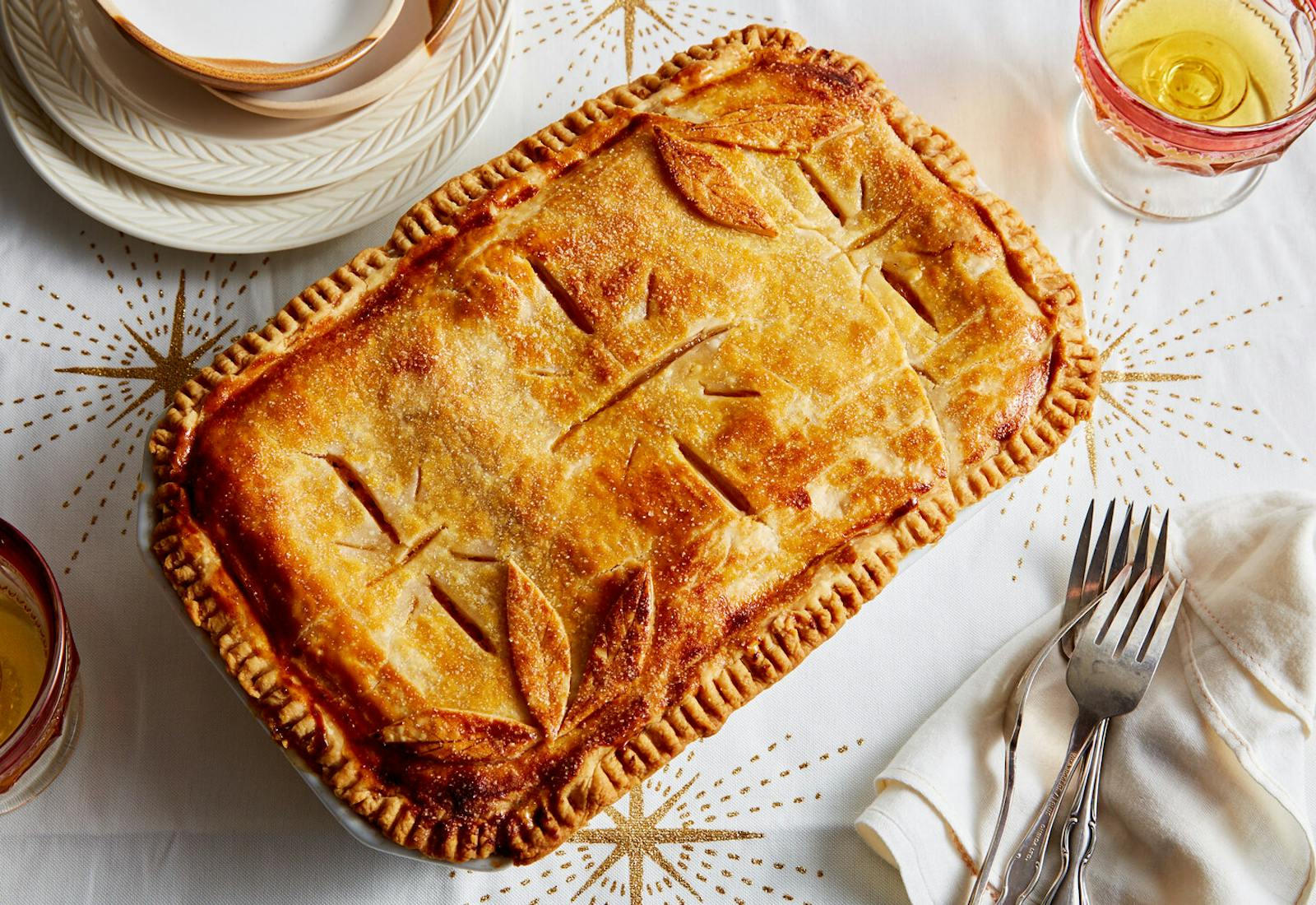
18. Strudel Aux Pommes (Apple Strudel)
Yield: 8 servingsTime: 1h 40 min or 2h 40 min (if preparing dough from scratch)Anna Polonsky’s family held onto their Jewish traditions and recipes after moving to France from Poland in the 1920s. Today, they call this recipe strudel aux pommes and make it with apples that are cooked as they would be for a tarte tatin — until caramelized and golden brown.
This recipe is featured in our cookbook "The Jewish Holiday Table: A World of Recipes, Traditions & Stories to Celebrate All Year Long." For more holiday recipes from around the world, get your copy!
Read more about Anna and Claude Polonsky in "Keeping Ashkenazi Recipes Alive in Paris" and try their recipes for klops (yiddish meatloaf), tsibeles (scrambled eggs), and cauliflower beignets.
Ingredients
For homemade dough:
- 4 cups all-purpose flour
- 3 ½ tablespoons sugar
- 1 teaspoon kosher salt
- 10 ⅔ oz (1 ⅓ sticks) cold unsalted butter or nondairy butter, cut into cubes, plus more for the pan
- 1 cup cold water
- ½ teaspoon vanilla extract
For the filling:
- 5 tablespoons unsalted butter or nondairy butter, plus more for the pan
- 6 to 7 Golden Delicious apples, peeled, halved lengthwise, and cored
- 1 orange, halved crosswise and seeded
- 1 lemon, halved crosswise and seeded
- 2 cups sugar
- 3 tablespoons golden raisins
- 1 tablespoon ground cinnamon
- 3 tablespoons dried breadcrumbs
For the egg wash and finishing:
- 1 large egg, beaten
- 1 tablespoon sugar
Preparation
Step 1
Make the dough: Put the flour, sugar, and salt in a food processor and pulse a few times to blend. Add the cold butter and pulse until the pieces are the size of green peas. With the processor running, pour in half the water and blend for 15 to 30 seconds. Add the vanilla and enough of the remaining water so the dough starts to hold together in a ball; you may not need the full amount of water.
Step 2
Transfer the dough to a floured surface nad gently knead a few times to bring it together into a smooth ball. Divide the dough in half and shape each piece into a 6-inch square. Tightly cover with plastic wrap and refrigerate for at least 1 hour.
Step 3
Meanwhile, caramelize the apples: Heat a large skillet over medium heat, add the butter, and place the apple pieces in the pan, flat side down. Cook, turning the apples occasionally, until lightly caramelized and golden brown all over, adjusting the heat so the butter doesn't burn. Take your time with this step so that the apples are nicely caramelized; it should take about 15 minutes. Remove the pan from the heat and set aside to cool.
Step 4
Preheat the oven to 350°F. Grease a 9-by-13-inch baking dish with butter.
Step 5
Make the citrus filling: Put the orange and lemon in a food processor and process to a fairly smooth puree. Transfer to a medium bowl and stir in the sugar, raisins, and cinnamon. Set aside.
Step 6
Shape the dough: Lightly flour a work surface. Roll out one piece of dough to a 13-by-17-inch rectangle, about ⅛ inch thick.
Step 7
Transfer the dough to the prepared baking dish and gently press it over the bottom and up the sides, leaving a bit of an overhang on all sides. Roll out the second piece of dough to a rectangle the same size as the first and set aside.
Step 8
Sprinkle the breadcrumbs evenly over the dough in the baking dish. Arrange the caramelized apples over the breadcrumbs in one layer. Pour the citrus mix evenly over the apples.
Step 9
Lay the second piece of dough over the filling, taking care to drape it rather than stretch it. Pinch the dough edges together to seal on all sides, trim off all but about 1½ inches, and then crimp the dough to make the edges look neat and pretty. Brush the surface of the pie with the beaten egg. With a sharp knife, cut about three 4-inch diagonal slits in the top of the dough. Sprinkle the sugar evenly on top.
Step 10
Bake the pie until the crust is a deep golden brown and the filling is cooked through, poking an apple through one of the slits to see if it is tender, 50 to 70 minutes. Check the pie halfway through, and if the top crust is browning too quickly, cover it loosely with aluminum foil. When the pie is done, remove it from the oven and let rest for about 20 minutes, so the filling can firm up a bit.
Step 11
Serve the pie warm, cut into slices.
Shared by Miriam Foster
19. Dinah's Apple Cake
Yield: 10” round tube cake panTime: 1 h 30 minShared by Miriam Foster
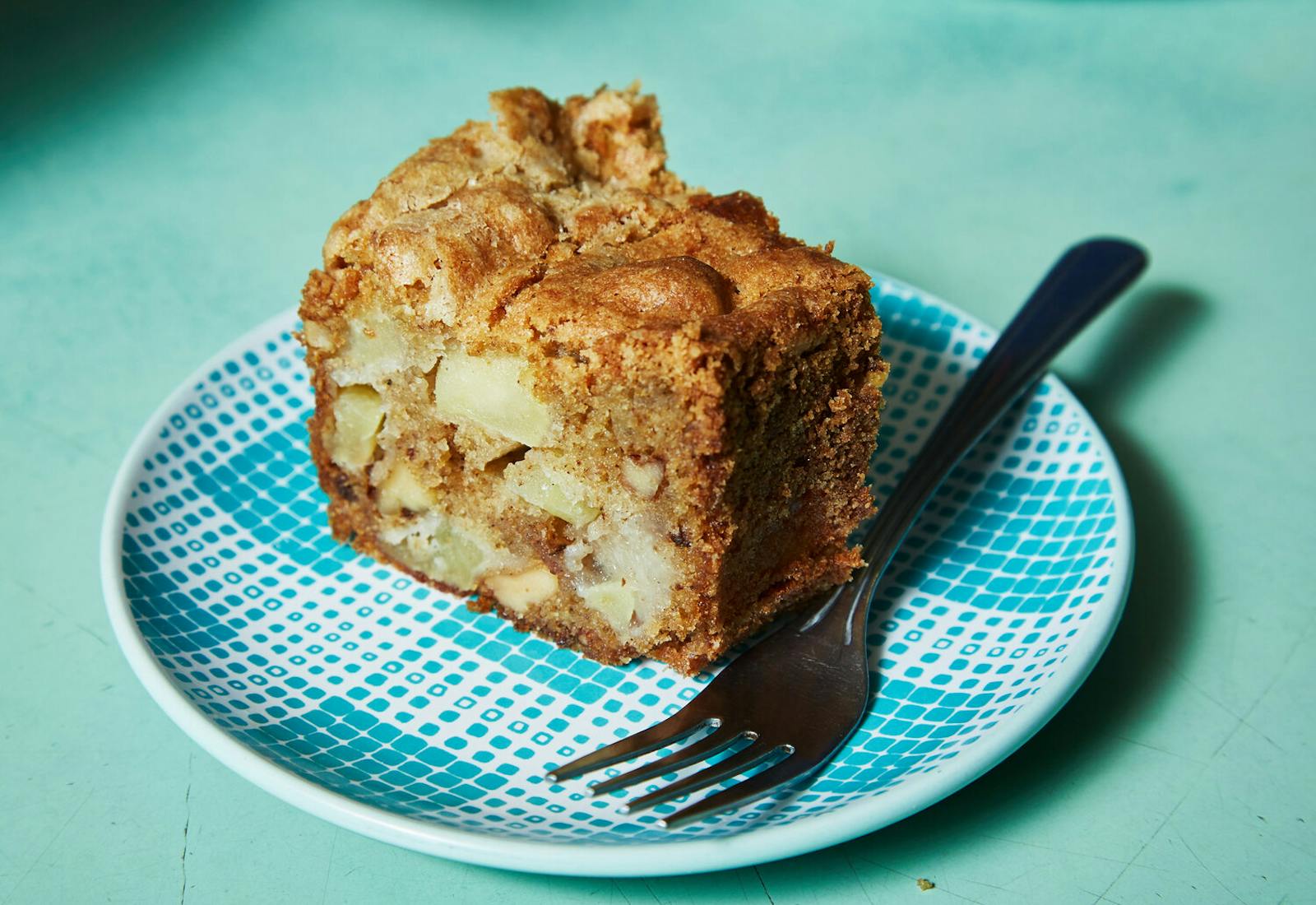
19. Dinah's Apple Cake
Yield: 10” round tube cake panTime: 1 h 30 minThis recipe was shared by Miriam Foster. Read more about her family in "Date-Filled Hamantaschen Mark Purim at the Orient Country Store" and try her recipe for date-filled hamantaschen.
Ingredients
- 1 ½ cups + ¼ teaspoon vegetable oil, divided
- 1 ¾ cups sugar
- 3 eggs
- 3 cups all purpose flour, sifted
- 1 teaspoon baking soda
- ¾ teaspoon salt
- ½ teaspoon ground cinnamon
- ½ teaspoon ground cloves
- ½ teaspoon ground ginger
- ½ teaspoon ground nutmeg
- 1 ½ cups roasted walnuts, roughly chopped
- 3 Gala apples, peeled and cored, chopped into 3/4 inch cubes
- ⅓ cup apple or orange juice
Preparation
Step 1
Preheat oven to 350 degrees.
Step 2
Grease the cake pan with ¼ teaspoon vegetable oil.
Step 3
Mix the wet ingredients: In a large bowl, whisk the vegetable oil and sugar until combined well and creamy. Add the eggs and whisk again until combined and thick. Set aside.
Step 4
Mix the dry ingredients: In a separate bowl, whisk the flour, baking soda, salt, cinnamon, cloves, ginger and nutmeg until combined. Add walnuts and apples and toss in the mixture until all pieces are coated in the dry ingredients.
Step 5
Pour the wet ingredients into the bowl with the dry ingredients and stir well until incorporated. Add the apple or orange juice and mix well.
Step 6
Place the batter into the loaf pan, using a spatula push the batter to cover all the bottom edges of the pan. Transfer to the oven and bake for 50 to 65 minutes minutes until golden brown.
Step 7
Cool the cake for 10 minutes. Turn the pan over onto a cooling rack. Let the cake cool for another 25 minutes. This cake is oil-based and will fall apart if not left to cool long enough.
Step 8
Serve at room temperature.
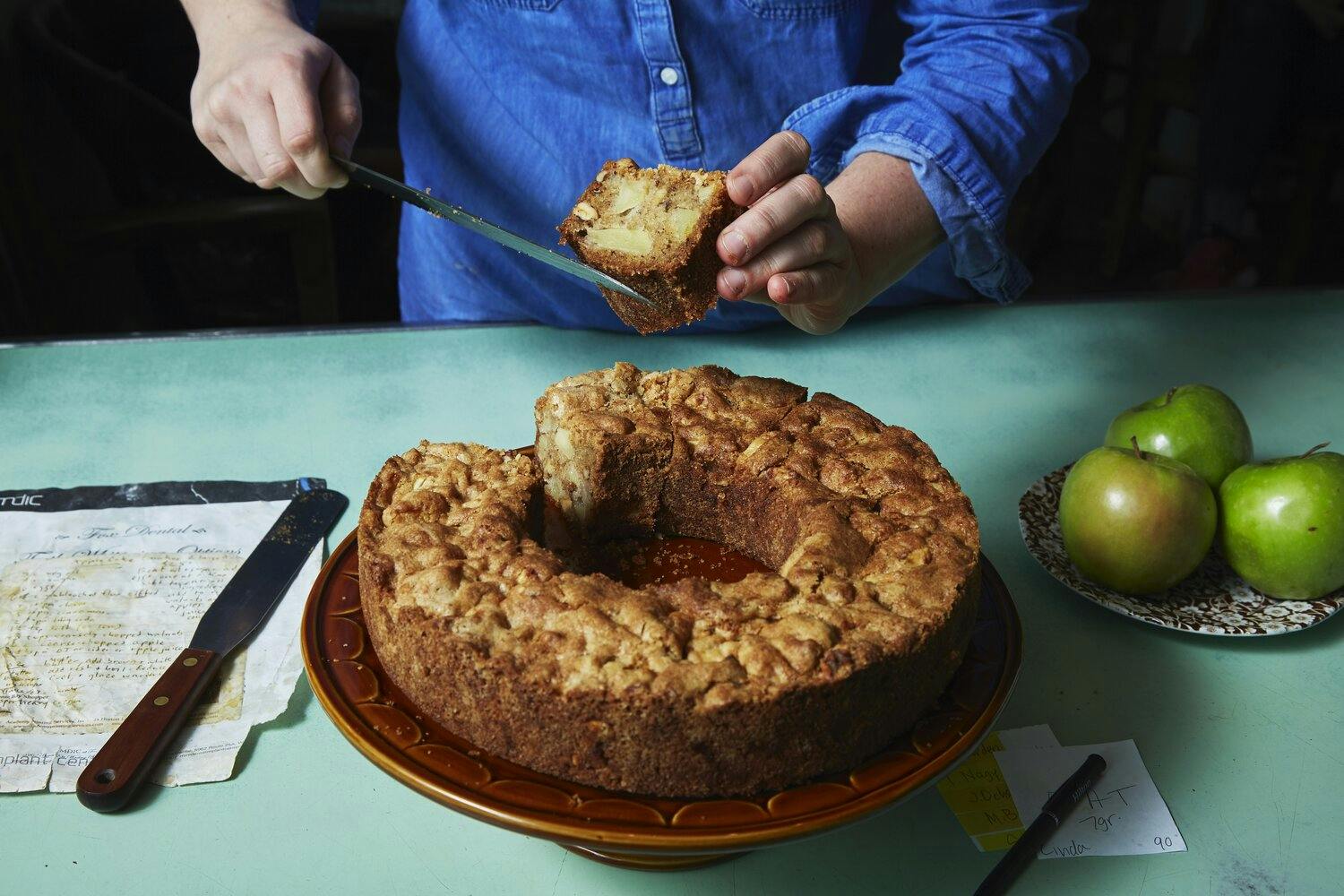
Shared by Adeena Sussman
20. Triple Ginger Persimmon Loaf
Yield: One 9-inch by 5-inch loafTime: 1h 25minShared by Adeena Sussman
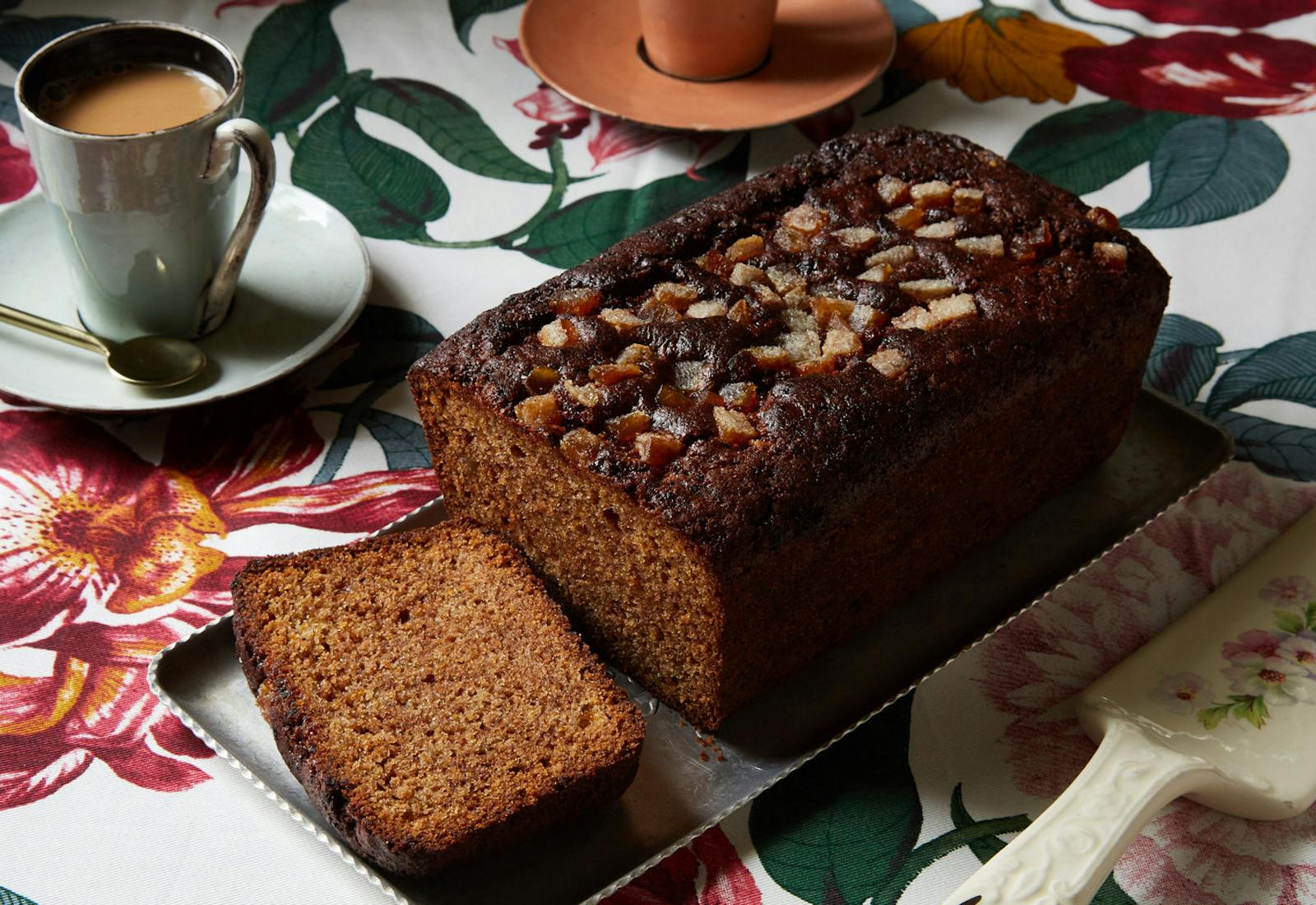
20. Triple Ginger Persimmon Loaf
Yield: One 9-inch by 5-inch loafTime: 1h 25minCookbook author Adeena Sussman explains: "Once a week during high season my mother would make her persimmon bread, a dense loaf cake with caramelized corners we’d warm in the toaster oven after school. The edges would almost burn, turning crispy from the combination of sugar and that intense toaster heat. We couldn’t spread the cream cheese on top fast enough, so much so that half of it would slide off while we burned the roofs of our mouths with each bite. Here is a slightly springier, lusher version that’s great fresh out of the oven, even better the next day—and best toasted, with a schmear of labneh or cream cheese."
When you're shopping for persimmons, keep in mind that longer, tapered Hachiya persimmons get softer — and more quickly — than the rounder, smaller Fuyus, but both can work. Just make sure they’re really soft. If you need to, blitz the scooped flesh in a blender or food processor. If persimmons aren’t in season, you can substitute one pound of very ripe apricots or mango, peeled, pitted, and puréed in a food processor until smooth.
Read more about Adeena's family in "A California Persimmon Cake Finds New Life in Tel Aviv" and try her recipe for blintzes with cheese or potato filling.
Ingredients
- ¾ cup vegetable oil, plus more for greasing the pan
- 3 medium (1 pound) very ripe persimmons, preferably Hachiya variety*
- 2 large eggs
- ¼ cup water
- 1 teaspoon pure vanilla extract
- 1 cup sugar
- 1¾ cups all-purpose flour
- 1½ teaspoons baking soda
- ¾ teaspoon fine sea salt
- ¾ teaspoon ground cinnamon
- ¾ teaspoon ground nutmeg
- ½ teaspoon ground ginger
- ¼ teaspoon ground cloves
- 1 tablespoon chopped crystallized ginger, plus more for topping the loaf (optional)
- 1½ teaspoons freshly grated ginger
- Labneh or cream cheese, for serving
Preparation
Step 1
Preheat the oven to 350°F. Grease a 9-inch by 5-inch loaf pan with vegetable oil and line with parchment paper.
Step 2
Cut off the tops of the persimmons. Scoop the ripe flesh into a large bowl and mash it with a fork or potato masher until very smooth, or puree in a food processor or blender for 10 seconds. 3. Whisk in the ¾ cup vegetable oil, the eggs, water, vanilla, and sugar until well blended.
Step 3
In a separate medium bowl, whisk together the flour, baking soda, salt, cinnamon, nutmeg, ginger, and cloves. Stir the dry ingredients into the persimmon mixture until just blended, then gently fold in the crystallized ginger and the fresh ginger.
Step 4
Pour the batter into the prepared pan, top with additional candied ginger, if desired, and bake until the loaf is a deep burnished brown and a toothpick inserted in the center comes out clean, about 1 hour. Cool the loaf completely in the pan, then slice and serve with labneh or cream cheese.
Shared by Elazar Tamano
21. Ethiopian Honey Tart
Yield: 10-inch tartTime: 4 hoursShared by Elazar Tamano
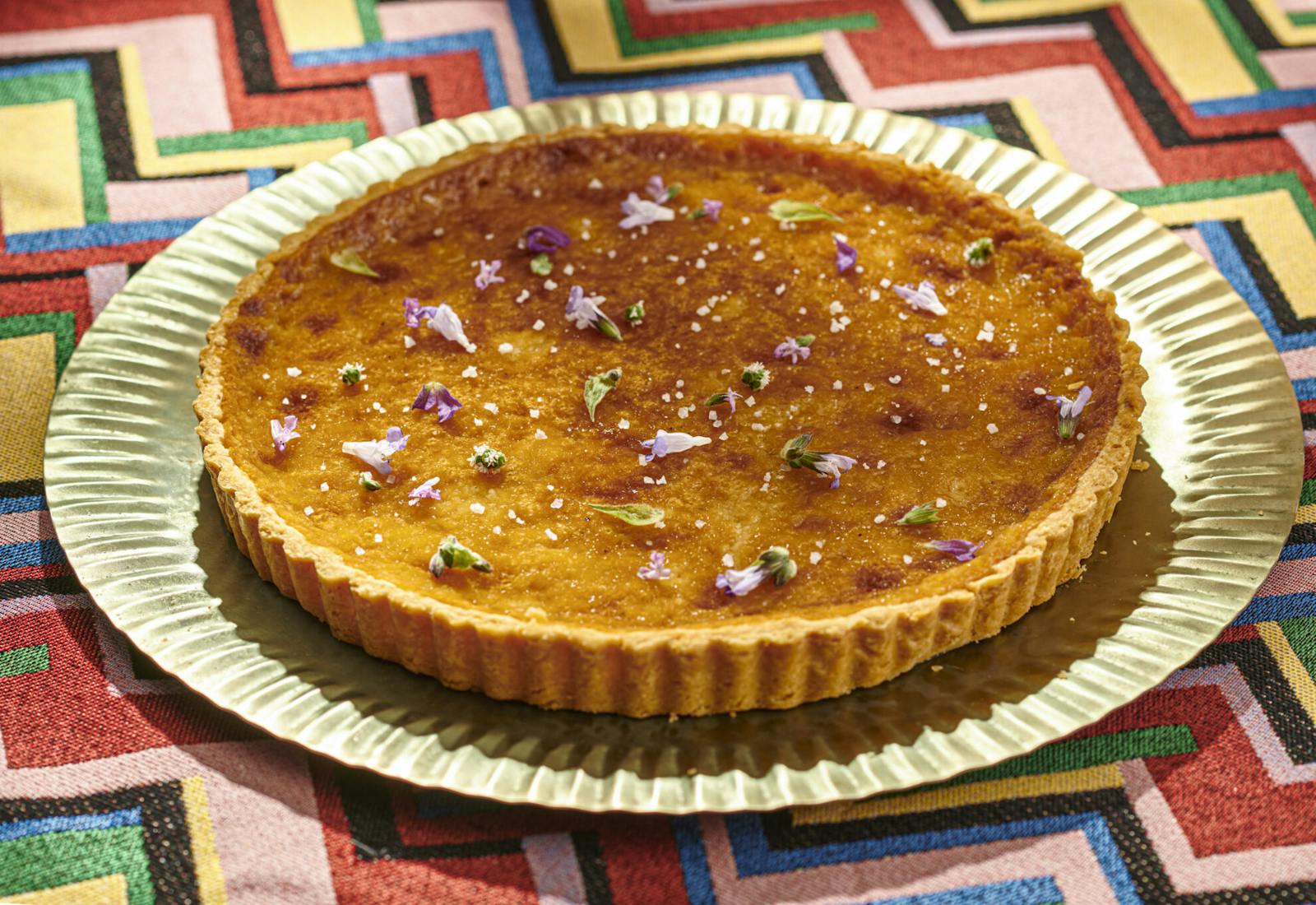
21. Ethiopian Honey Tart
Yield: 10-inch tartTime: 4 hoursThis sweet tart was inspired by a heritage trip chef and artist Elazar Tamano took with his father Melaku to Ethiopia. They visited Melaku’s old village where his neighbors welcomed them “with a rustic Ethiopian hospitality,” Elazar shares. “They have a beehive in the yard and keep the honey in barrels. We were served a huge honeycomb and Ethiopian coffee. I had never tasted honey like it before and wanted to share that experience through this tart.” He called it mare, a term for “sweetie” in Amharic.
Elazar uses Ethiopian white honey for this recipe and strongly recommends seeking it out. If you’re unable to, look for thicker honey with a grainy texture.
Read about Elazar’s family in “How Ethiopian-Israeli Chef Elazar Tamano Found His Place in the Kitchen” and check out his recipes for kifto, an Ethiopian beef tartare, injera, and more from our our partner Asif: Culinary Institute of Israel.
Ingredients
For the Pastry Dough
- 2 cups + 2 tablespoons all-purpose flour
- 3 tablespoons powdered sugar
- Pinch of kosher salt
- 7 ounces cold unsalted butter, cut into cubes
- 2 egg yolks
For the Honey Filling
- 4 egg yolks
- 5½ tablespoons honey
- 4 tablespoons cornstarch
- 2½ cups heavy cream
- ¾ cup sugar
- ½ teaspoon kosher salt
- ½ teaspoon ground cardamom seeds
To Serve, Optional
- Flaky sea salt
- Fresh oregano blossoms or hyssop leaves
Preparation
Step 1
Prepare the pastry: whiz the flour, salt, powdered sugar and cold butter in a food processor in short pulses to a crumbly mixture. Add the egg yolks and process just until the pastry dough starts to form (avoid over-processing). Shape the dough into a ball, wrap in plastic wrap, flatten to a disc and refrigerate for 30 minutes.
Step 2
Prepare the filling: Meanwhile, beat the egg yolks and honey in a bowl and set aside. Mix the cornstarch with a little heavy cream in a saucepan until smooth with no lumps. Add the remaining heavy cream while continuously whisking. Add sugar, salt, and ground cardamom and place the saucepan over medium-low heat. Cook, stirring continuously until thickened, about 10 minutes. Gradually and very slowly, pour this mixture into the bowl with egg yolks and honey, vigorously mixing. Mix until combined well into a smooth cream. Cover the surface of the cream with the plastic and cool in the refrigerator for at least 30 minutes.
Step 3
Preheat the oven to 325°F and grease the tart pan with butter.
Step 4
Roll the cold pastry between two sheets of parchment paper to ⅛ inch. Carefully transfer the piece of rolled out dough on top of the tart pan and use your hands to press the dough into the pan. Cut off any excess dough that hangs over the edge of the pan. Use any excess pieces of pastry to patch any tears. Freeze for 15 minutes.
Step 5
Blind bake the dough: Remove the tart pan from the freezer and line it with parchment paper which has been cut into a circle about the diameter of the bottom of the pan. Line again with tin foil, making sure all of the crust is covered. Fill with pie weights or dried beans and then place into the oven for 10 minutes, until the crust has just slightly browned. Carefully remove the pie weights or beans, tin foil and parchment paper.
Step 6
Pour the filling over the tart, smooth to an even layer and bake until the mixture is bubbling and amber in color, about 45 minutes. Cool for at least 2 hours.
Step 7
To serve: sprinkle a pinch of flaky sea salt, fresh oregano blossoms or hyssop leaves on top of the tart.

